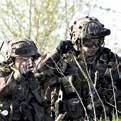The European Security and Defence Union

Europe and Space
Benefits for mankind versus growing geopolitical competition


Benefits for mankind versus growing geopolitical competition

From the Arctic Circle to the Black Sea, GA-ASI is a proud provider of advanced ISR capabilities for NATO’s most challenging requirements. Our proven multi-mission MQ-9B remotely piloted aircraft stands apart in capability and is ready now to deliver the interoperability, configurability, and versatility needed for unmatched situational awareness.
by Hartmut Bühl, Editor-in-Chief, Paris
Long before the start of Putin’s war against Ukraine on 24 February 2022, Russian preparations for a military offensive were revealed by observation satellites of various nations. Even though the world was provided with information on Putin’s military intentions and Russia’s operational readiness to attack Ukraine, European leaders decided to pursue a policy of appeasement, trying to save peace through diplomacy.
However, many things have changed since then, not least in space policy. Until recently, most of the treaties and agreements of the European Union (EU) and its Member States – from the Lisbon Treaty in 2009 to the 2021 Regulation for a new Space Programme (2021-2027) – referred essentially to the societal and economic dimensions of space.
Civilian space technologies and services have indeed become essential to our daily lives for communication and navigation. Satellites also provide immediate information about disasters, help secure transportation and energy infrastructure and are a valuable tool in the field of climate research. For many years however, defence and military applications were deliberately excluded from the EU’s space policy.
Only in 2022, with the Strategic Compass, did Brussels acknowledge that space-based systems are crucial for military engagement on earth and sea and advocated the coordinated protection of vulnerable systems by the western community. However, even in space, security and defence remain national prerogatives where it is difficult to reach consensus.
Against the background of the current geopolitical context of increasing power competition and threat intensification, the first ever EU Space Strategy for Security and Defence of March 2023 is a welcome move. The new strategy proposes action to protect European space assets, defend the EU’s interests, deter hostile activities in space and strengthen the Union’s strategic posture and autonomy.

Hartmut Bühl
These are essential measures for our future, in view of the serious challenges in outer space. Russia and China have carried out successful tests to prove that they can use anti-satellite systems to shoot down any satellite in space. More nations, including rogue states, are striving to develop space capabilities or divert civilian assets for military use. Furthermore, the fast-growing amount of space debris is an increasing threat to vulnerable high-tech space systems.
Alas, the Outer Space Treaty of 1967, which contains broad principles to guide the activities of nations in space, does not contain detailed rules for the use of space. While the treaty specifically prohibits weapons of mass destruction anywhere in space, it does not prohibit the use of conventional weapons or the use of ground-based weapons against space assets. There is therefore an urgent need for updated common rules governing safe, peaceful and sustainable activities in outer space.
Europe has a number of important assets to pursue a successful space policy, with its highly valuable space systems like Galileo, Egnos and Copernicus. It also uses excellent dual-use systems in its Space Surveillance and Tracking System (SST) as part of the EU’s Space Situational Awareness Initiative (SSA). In addition, individual EU Member States have many other capabilities to meet current challenges.
Today, it is essential to further bundle these capabilities into a joint and coordinated approach at all levels to underpin Europe’s strong role in space and guarantee its security.

Hartmut Bühl



The role of space in ensuring the European Union’s security
Timo Pesonen, Brussels 18 DOCUMENTATION
The EU Space Strategy for Security and Defence
19 Who does what
Space agencies and institutions in Europe
Nannette Cazaubon, Paris 21
The potential of European space capacities
Making better use of space
Interview with Margit Mischkulnig, Vienna 24 Thinking differently
Research for Europe’s security
Prof Dr-Ing Anke Kaysser-Pyzalla, Cologne
26 DOCUMENTATION
The European Space Programme 28
The need for societal legitimisation
The public value of space exploration
Dr Stefan Selke, Furtwangen
30
Space debris and satellite protection
Governance and security in outer space
Dr Antje Nötzold, Chemnitz
32 Story from Torrejón
Europe’s eyes in the sky
Nannette Cazaubon, Paris
Which
Stefanie
35
Supporting all types of missions
ESOC – Europe’s centre of excellence for satellite operations
Hartmut Bühl, Paris 36
The need for strong space infrastructure
Western sovereignty in space matters!
Sinéad O’Sullivan, Washington D.C.
37
38
Continuing peaceful space exploration
NASA – historic and new space strategies
Hartmut Bühl, Paris
A Japanese perspective
International cooperation for space security in the age of the great power competition
Prof Hideshi Tokuchi, Tokyo

40 Unprecedented challenges in space security
The added value for Europe in space cooperation with Asian partners
Luke Hally, Brussels
42 The strive for modern space technologies
The possible use of satellite launch vehicles for the carrying of warheads
Debalina Ghoshal, Kolkata

Marketing Report
Electronic warfare in space
Dennis-P. Mercklinghaus, Munich
47 Field report from Austria
The future EU CBRN Reconnaissance and Surveillance System
Hartmut Bühl, Paris
49 Marketing Report
Protecting cities and people –expertise from Singapore
Interview with Chua Jin Kiat, Singapore

Masthead

THE EUROPEAN –SECURITY AND DEFENCE UNION
Volume 51 2/2024
www.magazine-the-european.com
Published by Mittler Report Verlag GmbH A company of the TAMM Media Group

Office Address: Mittler Report Verlag GmbH
Beethovenallee 21, 53173 Bonn, Germany
Phone.: +49 228 35 00 870 Fax: +49 228 35 00 871 info@mittler-report.de www.mittler-report.de
Managing Director: Peter Tamm
Editorial Team
Editor-in-Chief: Hartmut Bühl (hb)
Deputy-Editor-in-Chief: Nannette Cazaubon (nc)
Editorial Assistant: Céline Angelov
Translation: Miriam Newman-Tancredi Philip Minns
Free Correspondents: Gerhard Arnold (Middle East)
Debalina Ghoshal (India/South Asia) Ioan Mircea Pașcu (Southeast Europe) Hideshi Tokuchi (Japan/East Asia)
Copy Editor: Christian Kanig
Layout: AnKo MedienDesign GmbH, Germany
Production: Lehmann Offsetdruck und Verlag GmbH, 22848 Norderstedt, Germany
Advertising, Marketing and Business Development
Achim Abele
Phone: +49 228 25900 347 a.abele@mittler-report.de
Exhibition Management and Advertising Administration: Karin Helmerath
Advertising Accounting: Florian Bahr
All rights reserved. No part of this publication may be reproduced without prior written permission of the publisher in Bonn.
Cover Photo: Adobe Stock / roadrunner
Reduced annual subscription rate for distribution in Germany: €95.00 incl. postage
Annual subscription rate:€ 78.00 incl. postage



(nc) In a statement on 4 June 2024, EU High Representative Josep Borrell said that the EU gives its full support to the three-phase roadmap proposal from Israel to Palestinian Islamist group Hamas to end the war in Gaza. The roadmap for a ceasefire, the release of Israeli hostages and Palestinian prisoners, and the reconstruction of Gaza was announced by US President Joe Biden on 1 June. The EU High Representative stated that “the EU appreciates the determined efforts by the US, Egypt and Qatar in facilitating negotiations to bring an end to the war between Israel and Hamas, while ensuring Israel’s security, to which the EU remains fully committed”. Borrell further underlined that the EU urges both parties to accept and fulfil the three-phase proposal and “stands ready to contribute to reviving a political process for a lasting and sustainable peace, based on the two state solution, and to support a coordinated international effort to rebuild Gaza”.
➭ See the article by our Middle East correspondent on Page 12-13
Ukraine
Turnaround in the Ukraine war

(hb) Russia’s attack on the Kharkiv region finally caused a change of mind in western states regarding strikes against Russian territory with the weapon systems they deliver to Ukraine. In early June 2024, the United States and other NATO allies, including Germany, allowed Ukraine to use these weapons for limited strikes on Russia’s soil in order to prevent a possible concentration of Russian troops for a larger offensive in border areas. Until then, NATO states had agreed to supply weapons systems and ammunition to Ukraine only for the defence of Ukrainian territory against the Russian aggressor. US President Joe Biden feared escalation and repeatedly warned of a third world war, and German Chancellor Olaf Scholz clearly rejected the delivery of Taurus cruise missiles to Ukraine because they could hit Moscow. In response to the recent permit, Putin warned that he could arm western opponents around the world. This did not impress French President Emmanuel Macron: on 7 June 2024, in the presence of Ukrainian President Volodymyr Zelenskyy, Macron announced the possibility of sending French military trainers to Ukrainian soil and of providing Mirage 2000-5 fighter jets to the country.
(nc) The latest Eurobarometer survey is out, reflecting the opinion and expectations of EU citizens ahead of the European elections. Released on 23 May 2024, the survey shows that 77% of Europeans are in favour of a common defence and security policy among EU countries while over seven out of ten EU citizens (71%) agree that the EU needs to reinforce its industrial capacity to produce military equipment. In the medium term, Europeans consider that security and defence (34%) is the priority area for EU action, followed closely by climate and the environment (30%). Health (26%) comes third, economy and migration fourth (both 25%). Among the most recent crises, Russia's invasion of Ukraine has had the greatest influence on EU citizens’ vision of the future (42%), followed by the pandemic and other health crises (34%) and the economic and financial crisis (23%).

https://bit.ly/3VJ94N3
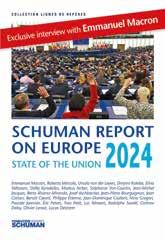
(nc) In April 2024, the Robert Schuman Foundation published the 18th edition of its “Report on Europe, the State of the Union”, edited by Pascale Joannin. This excellent book brings together key figures from politics, including the French President, the President of the European Commission and the President of the European Parliament, and gives the floor to people from the worlds of business, research and diplomacy. Their view on the European Union is completed with original maps and commented statistical data, which make the publication a vital tool to understand the multi-dimensional challenges facing contemporary Europe. The report can be purchased in French and English via the foundation's website. https://www.robert-schuman.eu/en/bookshop

(hb) On 9 May 2024, German Federal Defence Minister Boris Pistorius, invited by the American-German Institute and the Johns Hopkins University’s School of Advanced International Studies, held a speech in Washington where he stated that “this year, Germany will spend more on defence than ever before in the history of the Bundeswehr”. He added: “I am working hard to ensure that our spending and our investments will continue to rise. Two percent are our floor, not our ceiling.” Pistorius further stated that work is ongoing to prepare the Bundeswehr for today’s challenges and expressed his conviction that Germany, which suspended the obligatory military service in 2011, “needs some kind of military conscription. We need to ensure our military staying power in a state of national or collective defence.” While this topic remains politically sensitive in Germany, in other NATO nations an increased emphasis on conscription as a key part of the military’s toolbox can be observed.

Pistorius’ speech: https://bit.ly/3yPVY7n

(hb) On 4-5 June 2024, the 8th edition of the European Civil Protection Forum took place in Brussels with about 1,500 participants under the theme “Shaping a disaster-resilient Union: charting a path for the future of European civil protection”. The excellently organised event brought together experts, policy makers, first responders, scientists and the private sector, who discussed the latest evaluation (adopted on 29 May 2024) on the Union Civil Protection Mechanism (UCPM). The evaluation, presented at the Forum by Commissioner for Crisis Management Janez Lenarčič shows that a more coordinated response across different sectors and levels will be needed in the face of the increasing number and severity of complex emergencies. While the Emergency Response Coordination Centre (ERCC) and rescEU – the EU's own reserve of equipment and supplies to respond to disasters – are evaluated positively, there are also concerns that the UCPM's flexibility might not be sufficient to address all new needs and developments.

https://bit.ly/3KBMQWM
(nc) On 29 May 2024, the European Union unveiled its new office dedicated to Artificial Intelligence (AI), established within the European Commission. The AI office aims at enabling the future development, deployment and use of AI to mitigate risks and foster societal and economic benefits and innovation. The office will play a key role in the implementation of the Artificial Intelligence Act, the world's first comprehensive law on AI which was provisionally agreed by co-legislators in December 2023 and should enter into force by the end of July 2024. The new office will be composed of 5 units (Excellence in AI and Robotics; AI Regulation and Compliance; AI Safety; AI Innovation and Policy Coordination; and AI for Societal Goods) and will employ more than 140 staff, including technology specialists, administrative assistants, lawyers, policy specialists, and economists, to carry out its tasks. It will be led by the Head of the AI office and will work under the guidance of a Lead Scientific Adviser and an Adviser for international affairs.


https://bit.ly/3z1XXFH
(nc) As highlights a recent study of the Vienna based European Space Policy Institute (ESPI), space has increasingly found its way into the political discourse of the European Parliament. The study explores the impact of space on political programmes and campaigns across Europe ahead of the European elections and reveals that space has seen a notable surge in interest with a 41% increase in space-related references compared to 2019 across party manifestos.

Study: https://bit.ly/3Xfc2de

➭ See our main topic on Europe and space, starting p.15
11 June 2024

by Hartmut Bühl, Paris
Europe has voted! The 720 Members of the European Parliament (MEPs) have been elected for the next five years by citizens in the 27 countries of the European Union (EU) on 6-9 June 2024. While for the past five years the EU was governed by a majority composed by the centre-right European People's Party (EPP), centre-left Socialists and Democrats (S&D) and Liberals (Renew Europe), a clear shift to the right can be observed after the 2024 elections.
While the EPP, the Parliament’s largest group, sees the number of its members increased to 186, never have so many groups of the far-right-wing spectrum gained the attribution of seats, never before have so many opponents of Europe been elected to the EP. On the other side, the Greens/European Free Alliance lost seats, notably through the vote in Germany, and the liberal Renew Europe also shrunk, mainly due to the French voters: the Renaissance party of French President Emmanuel Macron only received 14.6% of votes (13 seats), which is less than half of Marine Le Pen’s right-wing extreme Rassemblement National (RN) which earned a spectacular and unprecedented 31,7% of votes (30 seats) –a result that prompted the French President to announce new legislative elections by the end of June/beginning of July 2024.
However, the European Parliament election result allows for the formation of a pro-European coalition that wants to move Europe forward. But for this, intensive discussions between the EPP, the S&D and Liberals about content is required. The Parliament, but also the Council and the future Commission, will do well to address the issues that have shaped the election campaigns in almost all Member States, such as migration, the green deal, consumer purchasing power, and the protection of European industry. Not to forget: the advancement of a realistic European defence capability and common armaments in view of the threat from Moscow and the overall tied geopolitical situation.
In autumn, the next European Commission will take over for the period 2024-2029. The nomination of the Commission President is still pending. The EPP is certain that its top candidate, the cur-
rent President Ursula von der Leyen, will be her own successor. To do so, however, the governments of all Member States first need to vote on the candidates before the European Parliament can give its voice.
The candidate for the Commission presidency should not expose him or herself to trying to get decisive votes from the right-wing extremist spectrum of the Parliament. That would be the beginning of the end of the future of the European Union!
Last update: 11 June 2024


(nc) On 25 April 2024, NATO Secretary General Jens Stoltenberg received Atlantik-Brücke’s Eric M. Warburg Award in Berlin “for his outstanding dedication to the transatlantic friendship and partnership in turbulent times”.
“ I am convinced that Ukraine will prevail because its cause is just. Democracy is stronger than autocracy. And Putin is wrong that we are not willing or able to defend our values. We are. The war in Ukraine demonstrates that security is not regional. It is global.”
The award was handed over in Berlin by German Federal Defence Minister Boris Pistorius and the laudatory remarks were held by Dr Irina Scherbakowa, co-founder of Memorial, a Russian human rights organisation awarded the Nobel Peace Prize in 2022 for its mission to review political repressions in the former USSR and in today’s Russia.
Dr Scherbakowa said that Secretary General Stoltenberg, from the start, has understood the dangers that Russia’s aggressive behaviour against Ukraine meant for security and stability in Europe. She thanked the Secretary General, saying: “You did not have any illusions about appeasing Putin, instead you worked on building up the military strength of the alliance and urged us to prepare for the threats coming from Putin’s regime”.
Before presenting the award to the Secretary General, Minister Pistorius described him as “a man who speaks his mind and who stands up for his beliefs and values”. Referring to the situation in Ukraine, the minister expressed his belief that the situation in the country “is Europe’s most decisive and strategic issue today”.
In his acceptance speech, Jens Stoltenberg warned that in today’s Russia, “the past echoes loudly in the present. Thought is controlled, freedom is curtailed, opposition is crushed.” He added that, “as Russia has become more oppressive at home, it has become more aggressive abroad, waging a fully-fledged war in Ukraine.”
The Secretary General emphasised the need to strengthen the alliance’s deterrence and defence, increase support to Ukraine, and work with friends around the world to ensure that NATO maintains peace and prosperity for its one billion citizens. He showed confidence “that Ukraine will prevail because its cause is just. Democracy is stronger than autocracy. And Putin is wrong that we are not willing or able to defend our values. We are. The war in Ukraine demonstrates that security is not regional. It is global.”
The Atlantik-Brücke founded in 1952 is a non-profit organisation that has developed into a broad transatlantic professional network fostering cooperation between Germany, Europe, and North America, transcending sectors and party lines.

https://www.atlantik-bruecke.org/en/


by Stefanie Buzmaniuk, Senior Research Fellow and Development Manager, Robert Schuman Foundation, Paris
Although Europe provided a quick, united response to the full-scale Russian invasion of Ukraine in February 2022, a closer look at Franco-German strategies to stop Putin’s war over the last two years reveals major differences. The Franco-German tandem, that supposedly leads any European action in such sensitive matters, appears
dysfunctional on multiple levels. Despite the main goal –stopping the war and freeing Ukraine from Russian forces –remaining unchanged and clear, unfortunately Germany and France’s diverging approaches rarely coincide, and friction frequently emerges. Three main observations can be noted in this matter.

Firstly, it might seem paradoxical, but France and Germany both find comfort in their pre-war logic, even though essentially, they are contradictory.
France has invested heavily in a more European approach to defence. Its current President Emmanuel Macron has especially reiterated that the answer to Europe’s security and defence issues do not lie in the transatlantic alliance since the US is increasingly a partner that cannot be relied. After the start of the war in Ukraine, strengthening European defence mechanisms, joint actions, and investing in European defence industries has, for France, become ever pressing and obvious.
Germany, however, has long relied on the American security umbrella and shown attachment to its US partner in defence issues. The European scale has not been a priority for Germany – not even investments in its own defence – since only NATO seemed capable of defending Germany, and Europe as a whole. After Russia’s aggression, it became even clearer to Germany that NATO should be strengthened, and that Europe’s partnership with the US remains vital to defeat Russia.
Significantly, however, certain elements have changed more radically

for Germany, likewise for France 1, due to the war in Ukraine. Both have adapted their views to the new geopolitical reality and should theoretically have opened up to the possibility of more fruitful cooperation.
For instance, Emmanuel Macron has understood that NATO is indeed an integral part of European defence, it is not experiencing “brain death” as suggested in 2019, and that the transatlantic alliance needs to be fully engaged in the defence of Ukraine. In contrast to Germany, however, France believes this to be a short-term solution, as it is sceptical about any future reliance on the US. And so, the shift in the French doctrine has been slight, but still perceivable, and this might have impacted cooperation with Germany positively since their views now seem more aligned.
As for Germany, it was shocked by Russia’s move on Ukraine and on 27 February 2022 Chancellor Olaf Scholz spoke of a “Zeitenwende”,2 announcing a €100bn package devoted to its defence. Germany realised that it must take responsibility for its own security and not rely solely on the US, that it must contribute to European defence more generally, and that its partnership with France is vital – a realisation that should have brought it closer to its French neighbour who applauded the “Zeitenwende” speech at the time.
Both leaders have also drastically hardened their language against Russia and its president. At the beginning of the war, both tried to convince Putin through diplomacy to cease his attack. Today, Olaf Scholz and Emmanuel Macron both clearly stress that Russia needs to be defeated and diplomatic pathways
“ Franco-German divisions are playing directly into Russian hands.”
have been shut down by both leaders. Statements such as “Russia’s defeat is essential” (Emmanuel Macron, February 2024) and “If the Russian president believes that he just has to sit this war out and that we will weaken our support, then he has miscalculated” (Olaf Scholz, March 2024) clearly illustrate this. Over the last two years while Russia has been waging war in Ukraine, it is clear that “rapprochement” might have been expected between the two historic partners, but this has not taken place because the basic views of European defence and of how Europe should respond to the Russian attack have remained the same for France, as well as for Germany. This is mirrored in their actions which have not occurred in unison, but rather unilaterally.
Secondly, the German decision to send US-Israeli rather than European military equipment to Ukraine – the latest decision being to deliver a third US Patriot air defence system in March 2024 – has led to major rifts as France insists on the need to buy European to strengthen the Union’s defence industry and, in fine, enhance its security sovereignty. Germany’s argument has
been that European equipment would not have been manufactured as fast, deeming France’s approach too unpragmatic in this emergency. France, however, views Germany’s approach to be too short-sighted.
Moreover, the French President’s suggestion of possible boots on the ground in Ukraine after the international conference in Paris in February 2024,3 led to Germany’s ire and a negative response by Olaf Scholz. This major disagreement came amidst debate over whether Germany would send Taurus systems to Ukraine – a decision against which the German chancellor voiced his firm opposition as he feared this would imply direct German involvement in the war. Trying to explain his decision, the chancellor said that “what the British and French are doing in terms of target control and monitoring of target control cannot be done in Germany”. France and Great Britain were surprised by a sensitive revelation such as this to the press which did not help smooth out Franco-German relations, on the contrary.
Thirdly, finding common approaches in the future will be increasingly difficult as mistrust, misunderstandings, and disappointments continue to grow and are more frequent. Recurring accusations have meant that clichés have started to fly between German and French officials, the media and the public, without much will to understand each other.
Debate over figures issued by the Kieler Institute is an interesting example in that sense. According to its statistics, Germany is the second largest donor to Ukraine (after the US) with France providing less than half of the military aid that Germany does. France explains this disparity with various arguments, but significantly here Germany persists in saying that France is lagging considerably behind, and France constantly accuses Germany of not sending the most pertinent equipment.
The most fruitful strategy – a strong Franco-German tandem pushing for a coherent European approach – seems to be the one losing out. And this is the one clear conclusion that must be drawn. Franco-German divisions are playing directly into Russian hands, although their approaches could be complementary, and their views brought together in a constructive way. ■

Stefanie Buzmaniuk is Senior Research Fellow and Development Manager at the Robert Schuman Foundation where she previously held the position of Head of Publications. Furthermore, she is an external lecturer at the French business school ESSEC, teaching the course “European Kaleidoscope”. She also worked as Research Assistant in the German-British think tank Convoco in London. Her research focus lies on the politics of European migration, the Franco-German relationship, and European identity.
© Adrien Thibault


TIran is a major obstacle to peace
by Gerhard Arnold, publisher and theologican, Middle East correspondent of this magazine, Würzburg
he states of the Middle East have experienced considerable upheavals over the past few years, which should in principle lead to a reduction in tensions and greater stability. However, the Gaza war and the de facto state of war between Israel and Iran harbour considerable potential for escalation. The biggest factor of uncertainty remains the regime of the mullahs in Iran.
The group of four on the move
Egypt, Bahrain, the United Arab Emirates (UAE) and Saudi Arabia, who call themselves “the quartet” see themselves as the vanguard of a new and better Arabia. The shock of the “Arab Spring” in 2011 made them realise that there is an urgent need for rapid economic and social improvements in the Arab world to give young people prospects for the future. The Egyptian government under al-Sisi does not need any new unrest and the population, which now stands at almost 110 million, needs better living conditions but has insufficient resources of its own. Population pressure and growing supply insecurity threaten the country's continued political and social stability.
Non-alignment as a new strategic goal
The upheaval in the Arab states of the Middle East also encompasses the geopolitical reorientation that Saudi Arabia in particular, the economically and politically strongest power
on the Arabian Peninsula, has pursued following the confusing policies towards the Middle East of US Presidents Donald Trump and Joe Biden. Today, the main plank of Joe Biden’s security policy is containing China, combined with a stratgic withdrawal from the Middle East. In response, Saudi Arabia’s Crown Prince, Mohammed bin Salman (MbS) has also been seeking better relationships with China and Iran as part of his own geopolitical reorientation. On 18 March 2023, the Saudi and Iranian foreign ministers agreed in Beijing on a rapprochement and the resumption of diplomatic relations. The Saudi leadership is also hoping that this will put an end to the missile and drone attacks on Saudi territory by the pro-Iranian Houthis in Yemen.
But economic developments are also driving Saudi reorientation towards non-alignment. MbS is looking to the post oil era and wants to diversify its economy, promote tourism and become the new banking and technology centre of the Middle East. This involves opening up the country to Chinese investors in particular.
His “Vision 2030” includes a gigantic construction and technology programme.
Syria's readmission to the Arab League at the instigation of Saudi Arabia – publicly celebrated at the summit in Jeddah on 19 May 2023 – was also linked to the hope that Syrian leader Assad would now make serious efforts to end the civil war in his country.

One of the positive developments in the Middle East is the attitude towards Israel. The small island kingdom of Bahrain under King Hamad al Khalifa began to visibly improve its political relations with Israel as early as 2017. The leading ruling house in the UAE, the Sheikh Zayid al Nahyan family, also made the pragmatic calculation that Israel was a very interesting military and technological cooperation partner.
With strong support from the then US President Donald Trump, the “Abraham Accords Declaration” between Israel, Bahrain and UAE was signed in Washington on 15 September 2020. They established diplomatic relations between Israel and the two Arab states and opened up prospects for greater cooperation in the economic and technological fields. Regional peacebuilding was also agreed. Morocco joined the agreement on 10 December 2020 and Sudan on 7 January 2021.
Due to pressure from the Arab populations, the Gaza war has led to a temporary standstill in cooperation under the Abraham Accords Declaration. Saudi Arabia is now likely to be prevented from formally joining the Abraham Accords for some time, but will continue to cautiously explore further rapprochement with Israel informally, despite the sceptical attitude of its own population.
“ The serious efforts by several Arab states to achieve regional stability, including with Israel, are being massively fought by Iran.”
Since the mullahs came to power in Iran in 1979, the Shiite country has pursued a largely destructive regional policy. At its core is the effort to export the Shiite revolution to neighbouring Sunni Arab countries and destabilise them. In addition, the regime wants to drive the US, with all its might, out of the Middle East and wipe out Israel, which it sees as a vassal of the US.
Iranian proxies have made massive efforts to destabilise Iraq since the Iran/Iraq War in 2003. Iran's political and military influence in Syria since the beginning of the civil war in 2011 is considerable, above all due to its military involvement in supporting the Assad regime. Iranian military bases threaten Israel. The regime has also been supporting the Houthi rebels in Yemen for some years and has allowed them, at the very least, to attack Saudi Arabia, the UAE, and now also Israel, with rockets and cruise missiles. Lebanon has been completely destabilised politically and is economically devastated, not least due to the efforts of the pro-Iranian Hezbollah, a Shiite militia.
Can there be peace with this problem state? No. The serious efforts by several Arab states to achieve regional stability, including with Israel, are being massively fought by Iran.
Against this background, Iran’s dangerous nuclear programme also has to be mentioned, particularly because Iran now produces highly enriched uranium that can be used to make nuclear weapons. The Iranian mullah regime is therefore the biggest obstacle to peace in the Middle East. Israel is particularly under threat because there are a number of Iranian proxies in its immediate neighbourhood: Hamas in the Gaza Strip, Hezbollah in Lebanon and the Assad regime in Syria, all of whom have vowed to destroy Israel. The major Iranian attack on Israel on 14 April 2024 has also heightened fears among neighbouring Arab states of more Iranian aggression.
According to popular opinion, the solution to the IsraelPalestine conflict lies in the so-called two-state solution, entailing the establishment of an independent Palestinian state. However, it would be more accurate to speak of a three-state solution because the Gaza Strip, under the rule of Hamas, has become a separate political area to the West Bank, which is self-governed by the Palestinian authority. Israeli society, which is now deeply divided, is probably no longer capable of making decisions with regard to a peace solution with the Palestinians. And seen in the cold light of day, the Gaza conflict is insoluble as long as 2.3 million people in 364 square kilometers have no basis for their economic existence. The Gaza conflict is therefore likely to be the hardest nut to crack in efforts to bring peace to the Middle East.
There are visible efforts underway to calm the conflict and restore stability in the Middle East, as Israel, the US and several Arab states are working intensively to this end. However, strong population growth, not only in Egypt, is exacerbating social problems in many Arab countries. In addition, new challenges are emerging, like climate change and water scarcity. Three further factors continue to put a strain on regional stability: the still smouldering civil war in Syria, the economic collapse of Lebanon and the almost failed state of Iraq. As unbearable as the IsraeloPalestinian conflict is and will remain, it is also clear that Iran, under the continuing rule of religious fanatics, is still the greatest threat to this already conflict-ridden region. This will remain the case with the successor of President Ebrahim Raïssi who died in a helicopter crash in May 2024. ■
Gerhard Arnold

is a German protestant theologian and publisher. Born in 1948, he published numerous monographs and essays in the field of contemporary church history on the themes and issues of ethics of peace and international security policy.

by Hartmut Bühl, Paris
In April 2024, French President Emmanuel Macron, in a speech at the Sorbonne University in Paris, warned of Europe’s downfall, saying that “our Europe is mortal”. He stated that Europe must free itself from its strategic immaturity and at the same time called upon Europeans to form an efficient pillar in NATO to strengthen the Atlantic Alliance.

Macron’s speech made it clear that he is striving for more distance from the United States to reduce Europe’s dependency on America and build European capabilities. He described the US and China as Europe’s competitors. “We need strategic credibility for Europe”, he said, moving at least semantically away from his first Sorbonne speech in 2017, in which he called for “strategic autonomy” for Europe. This was met with widespread incomprehension at the time. Macron later created the term of “strategic sovereignty” which became his leitmotif for a Europe that takes its fate into its own hands: he wants to counter Europe's loss of importance in all strategic areas: political, economic, military, but also social and human.
Besides the terms of “strategic autonomy” and “strategic sovereignty” and the currently employed “strategic credibility” which leaves things more open, he also shaped the expression “strategic ambiguity". For him, this means leaving Ukraine’s aggressor Putin in the dark as to whether and when western states will intervene directly in the conflict in Ukraine.
Macron’s second Sorbonne speech caused a lot of fuss, especially since he once again talked extravagantly about the question of Europe's nuclear protection. “Nuclear deterrence is central to France’s defence strategy. It is therefore essentially a critical element of defence of the European continent”, he said. In France, his opponents accuse the president of betraying his country and De Gaulle's doctrine of 3 November 1959 because he wants to “share” France's nuclear force with European partners. They fear that while sharing the deterrence, only France would have to face the risk of a counterattack.
Far from declassifying France’s nuclear capabilities, Macron did not talk about sharing the responsibility of the “force de frappe” as his opponents claim. And yet, in the context of his
proposal for a European air defence belt – a European strategic missile defence 360° preventing any missile from entering European space – he cleverly linked French deterrence to European security. Indeed, in doing so, he gives the French nuclear weapons a European dimension, but this goes no further than the nuclear capacity of France, as a member of the European Union, being in itself dissuasive and protecting France’s neighbours by its mere existence.
Macron’s proposal for the European air defence belt is to be seen against the background of the European Sky Shield Initiative (ESSI), a German-led project to build a ground missile capability based on an integrated European air defence system including an anti-ballistic capability. Currently, 19 European Member States are part of it, but not France. For strategic reasons related to its deterrence, the country was not prepared to participate, since the belt was not sufficiently designed, but also because Macron did not see France being adequately considered from an industrial point of view. By triggering the debate around a European air defence belt, Macron wants to make up for the mistakes made.
“ Nuclear deterrence is central to France’s defence strategy. It is therefore essentially a critical element of defence of the European continent.”
Emmanuel Macron
President Macron’s 2024 speech at the Sorbonne shows once again that he is a doer who loves everything but standing still. His inclination for provocations is not easy for his European neighbours; it is driven by the wish to get things moving. To serve French interests... and Europe’s, of course. ■

Macron’s speech: https://bit.ly/4bnia7y


Space technology, data and services have become indispensable to the lives of Europeans. They allow millions of people to communicate via new technologies, travel securely, help tackle the effects of climate change, and ensure the wellfunctioning of critical economic sectors. Space assets also gain strategic value in the security and defence field and geopolitical importance in today’s growing space competition. This dependency on space is double-edged: space assets are more and more exposed to security threats, be it through collisions in Earth's orbit overcrowded with satellites and space debris, or cyber-attacks and hostile activities in space.
A crucial nexus
by Timo Pesonen, Director-General, DG Defence Industry and Space, European Commission, Brussels

In today’s complex and volatile geopolitical environment, space plays a pivotal role. It is crucial to protect the safety and security of our citizens, safeguard the interests of the EU and our Member States and ensure the well-functioning of critical economic sectors.
As Director-General of the European Commission's Directorate General for Defence Industry and Space (DG DEFIS), I find myself at the nexus of space and defence that are increasingly intertwined. Space and defence are instrumental to the EU’s freedom of action, rely on complex programme management capacities and require a competitive technological and industrial basis. There are many commonalities that we need to fully leverage.
Timo Pesonen

is the current Director-General of the European Commission’s DirectorateGeneral for Defence Industry and Space. After graduating in 1989 in International Politics from the University of Tampere, he served at the Finnish Ministry of Foreign Affairs. From 2004 to 2014, he acted as Head of Cabinet of Vice-President Olli Rehn and from 2015-2019 he served as Director-General for Communication. He took helm of Directorate-General for Internal Market, Industry, Entrepreneurship and SMEs in March 2019 and he accompanied the creation of DG Defence Industry and Space in 2020 as the head of the new Directorate-General.
Over the past years, we have torn down walls between space and defence, both at EU and Member States levels. This paradigm shift is substantiated by the EU Space Strategy for Security and Defence of March 2023. The European Union recognises space as a strategic domain and a key enabler for security and defence, addressing a wide spectrum of security challenges,
“ The European Union recognises space as a strategic domain and a key enabler for security and defence.”
ranging from defence, terrorism and cyber threats to maritime piracy and natural disasters, to name just a few. The role of space in Member States’ security and defence strategies is becoming more pronounced, reflecting both the evolving nature of threats and the rapid development of space technologies. Space is crucial for modern security architectures, providing new capabilities for intelligence, surveillance, and reconnaissance, secure connectivity, as well as positioning, navigation and timing (PNT). Space-based technologies enhance our situational awareness and resilience both in space and on Earth and enable rapid response mechanisms.
The European Union space programme already provides tangible services, assets and tools in support of security and defence with the already well-known Galileo and Copernicus components. Galileo, the EU global navigation satellite system (GNSS), ensures independent and reliable PNT capacity, reducing our dependence on foreign systems and bolstering the resilience of critical infrastructures, such as energy grids, transport networks or banking and financial services. Copernicus, the Earth observation component of the EU space programme, provides timely and accurate geospatial information that underpins various security services, from border and maritime surveillance to environmental monitoring and disaster management. Moreover, the EU is actively pursuing the development of spacebased capabilities tailored to the specific needs of EU defence and security users. Investing in cutting-edge technologies like the ones needed for secure governmental satellite communications, for space situational awareness, or for in-space operations and services, also reinforces and complements Member States’ capacities.
While space assets gain strategic value in support of security and defence operations, they become more and more exposed to security threats, including to cyber-attacks or to hostile activi-
ties in space. The level of threats has drastically increased in the context of Russia’s unjustified war against Ukraine. We need to take action to improve the level of resilience and security of space infrastructure against cyber threats and electromagnetic interference. This is one of the priorities that we aim to address with the upcoming proposal for EU space law.
In tackling these challenges and seizing opportunities afforded by space, the EU must adopt a comprehensive and forwardlooking approach to better integrate security and defence needs into its space policy and the evolution of the EU space programme. This entails fostering closer collaboration between civilian and military stakeholders, leveraging public-private partnerships to drive innovation and investment in space technology, and strengthening our international partnerships to promote responsible behaviour in outer space.
While doing more for the competitiveness of our space industry, we need to increase our strategic posture as a space power. Our sovereign space capacities already offer services for security and defence and strengthen our strategic autonomy. As we look to the future, we are embracing the transformative potential of space and forging a path towards a safer, more secure and prosperous EU. ■

(nc) On 10 March 2023, the European Commission and the EU High Representative presented in a Joint Communication the “EU Space Strategy for Security and Defence” aimed at bridging the gap between space and defence.
The Strategic Compass of March 2022, issued one month after the Russian invasion of Ukraine, already identified space as a strategic domain in the geopolitical context of growing power competition and the intensification of threats. It underlined the need to boost the security and defence dimensions of the EU in space.
The new strategy is aimed to protect the EU’s space assets, defend its interests, deter hostile activities in space and strengthen its strategic posture and autonomy. It outlines the counterspace capabilities in the EU and main threats in space that put space systems and their ground infrastructure at risk. To strengthen the resilience and protection of space systems and services in the EU, the Commission will:
• Propose an EU space law to provide a common framework for security, safety, and sustainability in space, and ensure a consistent and EU-wide approach.
• Set up an Information Sharing and Analysis Centre (ISAC) to raise awareness and facilitate the exchange of best practices among commercial and relevant public entities on resilience measures for space capabilities.
• Launch preparatory work to ensure long-term EU autonomous access to space, addressing in particular the security and defence needs.

• Enhance the technological sovereignty of the EU by reducing strategic dependencies and ensuring security of supply for space and defence, in close coordination with the European Defence Agency (EDA) and the European Space Agency (ESA).
The strategy proposes the launch of two pilots: one for the delivery of initial space domain awareness services building upon capacities of Member States, and another for a new earth observation governmental service (EOGS). The latter will be made available to EU Member States in the next EU multi-annual financial framework (2028-2034) and will harness space data in support of autonomous European decision-making in the area of security and defence.
On 14 November 2023, the Council of the EU issued conclusions welcoming the new strategy. The Council proposed to:
• Increase the EU’s understanding of space threats through a yearly classified analysis, and the strengthening of military and civilian intelligence services on space security.
• Enhance the resilience and protection of space systems and services, acknowledging the Commission’s intention to propose an EU space law.
• Better respond to space threats through space domain awareness information, a dedicated toolbox for EU joint responses, and the further development of exercises.
• Enhance the use of space for security and defence purposes by better integrating the space dimension into Common Security and Defence Policy (CSDP) missions and operations; by strengthening the European Union Satellite Centre (SatCen); and by developing space services for governmental use at EU level, including by building on the EOGS pilot project proposed by the Commission. ■
“ Without security, there can be no future in space. (...) For the first time, we are putting forward a strategy that will pull together all our tools to protect EU space assets and ensure that everyone can benefit from space services.”
EU High Representative Josep Borrell
Who does what
by Nannette Cazaubon, Paris
Various agencies and institutions are involved in the implementation of the European Union’s (EU) space policy. Not all belong to the Union, there are also international and intergovernmental organisations that have signed agreements with the EU to support its space activities. In the following, we will highlight a few of them.
The European Space Agency (ESA), established in 1975, is an international organisation with 22 member states: 19 from the EU as well as Norway, Switzerland and the United Kingdom. Slovakia, Slovenia, Latvia and Lithuania are associate members; Bulgaria, Croatia, Cyprus, Malta and Canada have signed cooperation agreements with ESA. ESA is closely involved in the EU’s Space Programme through cooperation agreements. The agency’s mission is to promote, for exclusively peaceful purposes, cooperation among European states in space research and technology and their space applications, and to promote European industries. ESA’s activities include launchers, science, robotic and human exploration, navigation, Earth observation, telecommunications, space safety and operations. Headquartered in Paris, the agency has sites with different responsibilities in several European countries (see examples below). www.esa.int

The European Space Research and Technology Centre (ESTEC) in Noordwijk, the Netherlands, is ESA’s largest site and the agency’s technical heart. ESTEC provides the managerial and technical competences and facilities needed to initiate and manage the development of space systems and technologies. It operates an environmental test centre for spacecraft, with supporting engineering laboratories specialised in systems engineering, components and materials. ESTEC is supporting European space industries and works closely with universities, research institutes and space agencies all over the world. www.esa.int/About_Us/ESTEC
The European Space Operations Centre (ESOC) located in Darmstadt, Germany also belongs to ESA (mission control). Recognised internationally as a centre of excellence for spaceflight operations, ground system engineering and satellite astrodynamics, ESOC has successfully flown more than 85 satellites belonging to ESA and its partners since 1967. It is also home to ESA's Space Safety programme, focused on hazards in space. Currently more than 20 satellites are flown from ESOC,
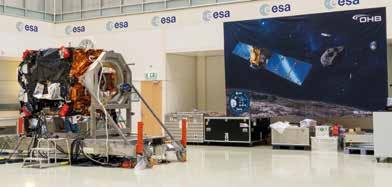
with a dozen new missions in development for future launch, including JUICE, Europe’s first mission to Jupiter.

https://esoc.esa.int
➭ See the article on ESOC, page 35
The European Union Agency for the Space Programme (EUSPA) headquartered in Prague, Czech Republic, is an EU agency under the supervision of the European Commission. Initially created as the European Global Navigation Satellite Systems Supervisory Authority (GSA) in 2004, EUSPA was established in its current form in May 2021. As an operational agency, EUSPA leads the implementation of the EU Space Programme, promotes spacebased scientific and technical progress, and supports the competitiveness and innovative capacity of the space industry sector. The agency advances the commercialisation of Galileo, EGNOS, and Copernicus data and services, engages in secure SATCOM (GOVSATCOM & IRIS²), and operates the EU Space Surveillance and Tracking (SST) Front Desk.

www.euspa.europa.eu
The European Union Satellite Centre (SatCen) headquartered in Torrejón, Spain, is the EU’s geospatial intelligence agency. It provides products and services resulting from the exploitation of relevant space assets and collateral data (including satellite and aerial imagery), and related services to EU institutions and Member States. Established in 1992 as part of the Western European Union (WEU), SatCen became an EU agency in 2002 under the supervision of the Council of the EU and the operational direction of the EU High Representative. The centre supports the EU’s Common Foreign and Security Policy (CFSP) and Common Security and Defence Policy (CSDP), including European Union crisis management missions and operations.

www.satcen.europa.eu
➭ See the article on SatCen, page 32-34 ■

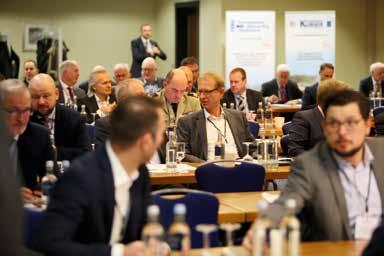
12./13. Dezember 2024
Van der Valk Hotel Brussel Airport
Erstmals im Maritim Hotel Königswinter
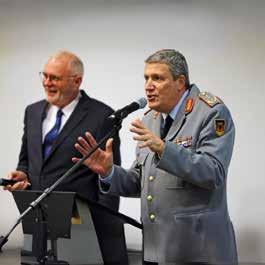
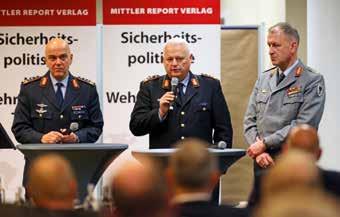

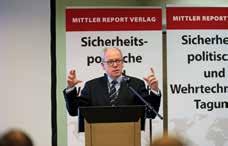
Kriegstüchtig – aber wie?
Zur Sicherheit Deutschlands und Europas nach der US-Wahl
Sichern Sie sich noch bis zum 15. August 2024 Ihr vergünstigtes Early-Bird-Ticket
Weitere Infos und Tickets: mittler-report.de/veranstaltungen/sipo

Interview with Margit Mischkulnig, Head of Department for Space Affairs, Federal Ministry for Climate Action, Environment, Energy, Mobility, Innovation and Technology, Vienna
The European: Ms Mischkulnig, you are the Head of the “Space and Aviation Technologies” department in the Austrian Federal Ministry for Climate Protection, Energy, Environment, Mobility, Innovation and Technology (BMK). An impressive variety of topics brought together in a single ministry in Vienna, whereas in other countries they are spread over several ministries. Does this create synergies or is it sometimes difficult to reconcile the different areas of your ministry’s responsibilities?
Margit Mischkulnig: Indeed, our ministry has a very broad remit and in addition, it is also Austria’s Space Ministry. Satellite-based data and services support the green and digital transformation of our society and economy and make a significant contribution to achieving Austria’s goal of climate neutrality by 2040. Therefore, it is very positive from the space perspective to have so many potential users in-house and to be able to cooperate closely to see where space data can satisfy these special needs.
The European: Can you give a concrete example of such cooperation?
Margit Mischkulnig: A good example is the development of a demonstrator called “The Green Transition Information Factory” (GTIF) that was developed by Austrian space companies in very close cooperation with the European Space Agency (ESA). GTIF makes the benefits and potential of space data very clear to the non-space sector.
The European: What significance do space and space technologies have for our European societies and for our future?
Margit Mischkulnig: Space technologies, data and services have become indispensable in our daily lives: when using mobile phones and car navigation systems, watching satellite TV, or withdrawing cash. Satellites provide immediate information about disasters and enable emergency and rescue services to be better coordinated. Agriculture benefits from improved land use. Transportation and energy infrastructure is safer and can be more effectively managed thanks to satellite technologies.
The European: And global challenges such as climate change require a lot of detailed information about our planet. What role can space-based solutions play in this challenging field?
Margit Mischkulnig: The 2021 report of the UN Intergovernmental Panel on Climate Change (IPCC) identified earth observation satellites as a critical tool to monitor the causes
and effects of climate change. More than half of the Essential Climate Variables defined by the Global Climate Observing System (GCOS) depend on space observations. Therefore, space assets are the key elements in providing observations and data that are global, uniform, sustained over years and repeated regularly.
The European: Space also has a role to play for our security by, for example, preventing military aggression through predictive intelligence. At the same time, space has become a place of global competition and the race to master space technologies runs the risk of exacerbating geopolitical conflicts. It seems to me that we are a long way from “peaceful space”?
Margit Mischkulnig: Space is indeed crucial for defence and security. The EU Space Strategy for Security and Defence of 2023 highlights the need to protect and increase the resilience of space infrastructure, strengthen technological sovereignty and address risks. And with the growing space economy, we also need to think about sustainability in space. There is a clear need for common rules governing safe and sustainable activities in outer space.
The European: What is the European strategy in this field?
Margit Mischkulnig: Europe is already taking first steps both in the observation and detection of space objects and in the management of space traffic, but we are only at the beginning.
The European: Is Austria playing a role in this process?
Margit Mischkulnig: Austria is very proud to have an international space hub in Vienna, with the UN office for Outer Space Affairs (UNOOSA) and the European Space Policy Institute (ESPI). Both already have sustainability in space on their agenda. To further advance work in this area, Austria will set up a Centre of Excellence for Space and Sustainability at ESPI, located in Vienna. The Centre aims to develop interdisciplinary expertise and know-how on the role of space in supporting sustainable development on Earth and will also address issues regarding the environmental footprint of the space sector itself as well as sustainability issues in outer space.
The European: We in Europe must no doubt combine all our efforts to make cooperative progress in space. Is Brussels doing enough to foster industrial synergies and human resources here?

“ Europe is destined to be a global space power!”
Margit Mischkulnig: Europe is destined to be a global space power! Increasing global competition forces the European Commission, the European Space Agency (ESA) and Member States to further strengthen cooperation.
The European: And what is the reality?
Margit Mischkulnig: Unfortunately, we are still a long way off. Nevertheless, I am convinced that it is essential to have a joint and coordinated approach at all levels to underpin Europe’s strong role in space. Furthermore, it is also necessary to communicate clearly to the outside world what goals are being pursued and what joint steps and measures are being taken to forge an independent and globally competitive European space sector.
The European: Although Austria is a small “space nation” compared to France, Germany, Italy and Spain, your country plays an important role in the concert.
Margit Mischkulnig: That is true. Austria’s membership of ESA and investment in specific ESA programmes as well as our national space funding have been an incentive for Austrian space companies to build up specific competencies and technological leadership, essential for participation in international value chains. A highly competitive supply chain
consisting of numerous dynamic small and medium-sized enterprises, an increasing number of start-ups and established research institutes characterise Austria’s space landscape. But the competition is tough!
The European: Space is a key driver for achieving the Sustainable Development Goals (SDGs). How do we introduce future generations to this topic?
Margit Mischkulnig: To illustrate the usefulness of space solutions, let me cite a 2018 study done by UNOOSA together with the then European Global Navigation Satellite Systems Agency (now named EU Agency for the Space Programme, EUSPA). This analysis shows that using space solutions has a positive impact on the implementation of all the SDGs. Space solutions help either monitor the status of achievement of a given SDG or actively contribute to its fulfilment. However, at the global level, we can see that space assets are often underutilised and access to the benefits of space remains unequal. There is a lack of information, skills and capacity to use space data.
The European: So, what steps need to be taken?
Margit Mischkulnig: We need to link the different sectors – space innovations and sector policies – more closely so that they can work together to develop innovative tools and solutions. In this sense, we are pursuing a real dynamic of change here in Austria through research, technology and innovation in the areas of climate neutrality and sustainability. We are convinced that innovation must become more transformative and be designed to advance sector policies and their objectives. In this way, we can create a bigger impact.

The European: Can you say a word about the report “EU Space supporting a world of 8 billion people: Contribution to the Space 2030 Agenda” published by UNOOSA and EUSPA in 2023?
Margit Mischkulnig: This joint report shows that cooperation at different levels between systems (Earth observation, GNSS, SATCOM, meteorology) and technologies (artificial intelligence, big data) and between stakeholder organisations (private and public partnerships, networks of academia or entrepreneurs) is of paramount importance to unlock the full potential of space technologies in countries and across continents.
“
I am convinced that it is essential to have a joint and coordinated approach at all levels to underpin Europe's strong role in space.”
The European: Isn’t that exactly the goal of the yearly Word Space Forum, to forge a new international consensus on how we deliver a better present and safeguard the future?
Margit Mischkulnig: You are right, the objective of this yearly event, launched by Austria and UNOOSA back in 2019, is to start a dialogue within the UN system that brings together diplomats, representatives from the space sector, policymakers, non-governmental organisations and young people. The last World Space Forum in November 2023 focused on providing space related input for the next Summit of the Future (September 2024) and the Pact for the Future. The zero draft of the Pact for the Future, which was presented at the end of January 2024, contains several paragraphs on outer space, for example: “We recognize that outer space is a rapidly changing environment and that there is an urgent need to increase international cooperation to harness the potential of space as a major driver of the Sustainable Development Goals.”
The European: Ms Mischkulnig, thank you for this conversation. I wish you every success in your important endeavours. ■

GTIF https://gtif.esa.int
Margit Mischkulnig
has been the serving Head of Department for Space Affairs at the Austrian Federal Ministry for Climate Action, Environment, Energy, Mobility, Innovation and Technology (BMK) since September 2017. Holding a master’s degree in economics from the University of Vienna, her areas of specialisation include macro- and microeconomics with specific focus on industrial policy. Ms Mischkulnig joined the BMK in 2015, after working in the Ministry of Finance, the European Commission, and the World Bank Group.
(hb) The Outer Space Treaty, which entered into force in 1967, provides the basic framework on international space law. Talks on preserving outer space for peaceful purposes began in the late 1950s, during the cold war. However, the proposals of the United States and its western allies submitted in 1957 on reserving space exclusively for "peaceful and scientific purposes" was rejected by the Soviet Union which was preparing for the launch of the world's first Sputnik satellite and the test of its first intercontinental ballistic missile. Finally, an agreement, the Outer Space Treaty ruling space activities, was reached in the United Nations General Assembly in 1966.
The Outer Space Treaty provides the following main principles:
• The exploration and use of outer space shall be carried out for the benefit and in the interests of all countries
• Outer space shall be free for exploration and use by all states and is not subject to national appropriation by claim of sovereignty
• The moon and other celestial bodies shall be used exclusively for peaceful purposes and states shall not place nuclear weapons or other weapons of mass destruction in orbit or on celestial bodies
• States shall be responsible for national space activities whether carried out by governmental or non-governmental entities and shall be liable for damage caused by their space objects.
Updating the treaty
Today, the Outer Space Treaty, although considered a good basis, is outdated. It lacks specificity and does not reflect the growing number of countries involved in space activities, the rapidly expanding space industry implying private actors, and new space technologies. And while the treaty specifically prohibits nuclear weapons in space, it does not prohibit the use of conventional weapons or the use of ground-based weapons against space assets.
A new negotiated international outer space treaty should provide clear rules or guidelines for activities such as space mining, satellite operations, or space tourism and should also cover space weaponry, space debris, and finally, sanctions in case of non-compliance.

https://www.unoosa.org/oosa/en/ourwork/spacelaw/treaties/introouterspacetreaty.html

Thinking differently, ahead, together!
by Prof Dr-Ing Anke Kaysser-Pyzalla, Chair of the Executive Board of the German Aerospace Centre (DLR), Cologne
The often-cited “Zeitenwende” describes the end of an epoch, the beginning of a new era. Geopolitical developments over the past two years have ushered in such a turning point for Europe that is unique and far-reaching. We at the German Aerospace Centre (DLR) are aware of this and are ready, with our partners, to help shape Europe’s new direction. Mastering upheavals and challenges together is in the DNA of a research organisation.
DLR is one of the largest research and technology centres in Europe. We work on technologies for use in industry and business, as well as by authorities, administration and public stakeholders. DLR fulfils its responsibility to society through the intensive, open exchange of knowledge and targeted technology transfer. Current geopolitical developments require us to secure and maintain what we do best – our long-standing skills and competencies in research and development and our ability to evaluate, analyse and evolve – but we also now need to build upon and broaden our expertise. By combining our deep knowledge in aeronautics and space with our capabilities in energy, transport and digitalisation, we can develop the full potential for security and defence research at DLR. However, this requires us to rethink security and defence research itself, together with our partners in politics, industry and research.
“ By understanding national and international strategic areas of interest, we can quickly incorporate solutions into our developing capabilities.”

Dr Anke Kaysser- Pyzalla has been the Chair of the Executive Board of the DLR since March 2020. Previously, she was the President of the Technical University (TU) Braunschweig (20172020). After the completion of her doctorate in mechanical engineering and materials science at the University of Bochum and research activities at the HahnMeitner Institute (HMI) and the TU Berlin, she taught as a university professor at the Vienna University of Technology (2003-2005). She then joined the management team at the Max-Planck-Institut für Eisenforschung GmbH in Dusseldorf as scientific member, director and then managing director. In 2008, she was appointed as scientific director of the Helmholtz Centre for Materials and Energy in Berlin.
To collaborate, providing reliable and resilient expertise across the entire spectrum of DLR research is just as essential a task as driving innovation and development and quickly translating this into applications and capabilities. To develop methods, processes and systemic solutions, we need the strength to sprint, combined with the stamina to run a marathon. Having this attitude will allow us to secure and maintain our national core competencies and international competitiveness in the long term. This turning point also emphasises the importance of joint efforts. To do this, we need the right partners in the right places: good relations, regular coordination and joint exercises with Bundeswehr departments and civilian authorities with security responsibilities are essential for our research. By understanding national and international strategic areas of interest, we can quickly incorporate solutions into our developing capabilities.
For a long time, it has been clear that applications and capabilities developed for space are vital for our existence – from Earth observation and navigation to transport and, of course, security and disaster management. All space exploration, from military to civil, requires working together. Protecting the orbital infrastructure we have come to rely on is a task for the Bundeswehr, ministries and authorities, in cooperation with politics, research and industry.
It is said that security and innovation go hand in hand. We can guarantee the security of society and its infrastructures through the skilful, expert mastery of technology. Reliable and secure research into defence technology is urgently required to guarantee this in the medium and long term. We also need to be open, incorporating results of research into the development of new capabilities and providing insights into what is required next. Above all, we need a stable “triangle of action”, consisting of security organisations, industry and research.
Security and defence research does not have to be about “the gold standard”; in other words, geared towards real needs, simplification and rapid deployment capability. Research is always risky and its output and answers cannot be known for certain in advance, but it is in a position to provide disruptive, genuinely novel solutions to the world’s problems. Achieving this involves effectively using the technological openness that exists today and incorporating research findings from civil research more quickly.
At DLR, with our many decades of experience and diverse range of skills, infrastructure and expert workforce, we are ready. ■

New Location: Van der Valk Hotel Brussel Airport
21/22 January 2025
New Location: Holiday Inn Brussels Airport

Get your discounted early bird ticket now until 15 September 2024
Further information and tickets: mittler-report.de/events/lcm




(nc) The satellites launched into Earth's orbit by the European Union (EU) enable millions of people to communicate via new technologies and travel safely by land, sea and air. Space assets help tackle climate change, improve crisis response and increase security. In April 2021, the Council of the EU and the European Parliament adopted a regulation establishing the EU’s first integrated space programme (with a budget of €14.88bn for the period 2021-2027) to support the Union’s space policy.
The regulation on the EU Space Programme simplifies the existing EU legal framework and governance system and standardises the security framework. It improves and brings together under one umbrella existing EU programmes such as Copernicus, Galileo, and EGNOS.
The regulation establishes the European Agency for the Space Programme (EUSPA) and assigns clear tasks to the institutions and agencies involved: the European Commission as the institution mainly in charge of the programme; EUSPA as the opera-
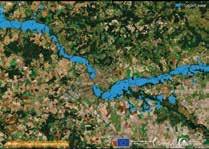
Copernicus is the EU’s Earth observation programme consisting of Earth observation satellites (Sentinel), in-situ sensors like ground stations, and airborne and seaborne sensors. Copernicus provides free information for urban area management, agriculture, forestry and fisheries, the mitigation of climate change effects, civil protection, transport, and tourism. Today, there are eight Sentinel satellites in orbit. The number is to increase to 20 before 2030. Copernicus is funded, coordinated and managed by the European Commission in cooperation with the European Space Agency (ESA) and the European Organisation for the Exploitation of Meteorological Satellites (EUMETSAT).
tional manager of Galileo and EGNOS, and responsible for the security and development of downstream applications for all components of the space programme; and the European Space Agency (ESA) responsible for research and development.
The main objectives of the programme are to:
• Provide or contribute to the provision of uninterrupted, highquality, up-to-date and, where appropriate, secure spacerelated data, information and services.
• Maximise socioeconomic benefits to enable growth and job creation and promote the widest possible uptake and use
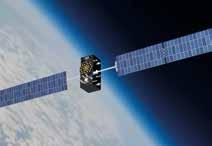
Galileo is Europe's global satellite navigation and positioning system (GNSS), on which numerous EU economic sectors rely, from transport and agriculture to border management and search and rescue. The system consists of a ground, user, and space segment with currently 30 satellites orbiting Earth at an altitude of 23,000km. Galileo’s signals, providing 20cm accuracy, are freely transmitted and more than 2.5bn smartphones are already Galileo-enabled. Galileo is a joint initiative of the European Commission (overall responsibility), the European Agency for the Space Programme, EUSPA (operational management) and ESA (system evolution).

The European Geostationary Navigation Overlay Service (EGNOS) is Europe's regional satellite-based augmentation system (SBAS). EGNOS has been deployed to provide safety of life navigation services to aviation, maritime and land-based users over most of Europe. Today, EGNOS uses a set of geostationary satellites and a network of ground stations to increase the accuracy of GPS. A more powerful system (EGNOS V3), currently in preparation, will strengthen both Galileo and GPS signals. The exploitation of EGNOS is the responsibility of EUSPA, the operational management and maintenance of EGNOS is assigned to the EGNOS service provider under a contract with EUSPA.
of the data, information and services provided by the programme’s components both within and outside the EU.
• Enhance the safety and security of the EU and its EU Member States and reinforce EU autonomy, in particular in terms of technology.
• Promote the EU’s role in the global space sector, encourage international cooperation, reinforce EU space diplomacy and strengthen its role in tackling global challenges, supporting global initiatives and raising awareness of space as a common heritage of humankind.
• Enhance the safety, security and sustainability of all outer space activities concerning space objects and space debris proliferation, along with the space environment. The programme also introduces new security components, such as the Space and Situational Awareness (SSA) programme, which monitors space hazards, and the Governmental Satellite Communication (GOVSATCOM) initiative aimed at providing national authorities with access to secure satellite communications.
Two new flagship initiatives
In February 2022, the European Commission proposed two new flagship initiatives. The first is IRIS², a secure connectivity system that will provide ultra-fast and highly secure communication services by 2027. The second is Space Traffic Management (STM), as the exponential applications of space services involve more and

The European Union Governmental Satellite Communications (GOVSATCOM) programme aims to provide secure and cost-efficient satellite communications capabilities to security missions and governmental operations managed by the EU and its Member States. Facing threats ranging from natural disasters, pandemics or cyberattacks to traditional forms of conflict or instability, security actors will benefit from a guaranteed access and protection against interference, interception, intrusion, and cybersecurity risks. GOVSATCOM is being established by pooling the capacities of governmental and commercial satellite communication providers. The first implementation phase is running until 2025.
Rocket launches since 1957: about 6,500 (excluding failures)
Satellites placed into Earth’s orbit: about 16,990
Satellites still in space: about 11,500
Satellites still functioning: about 9,000
Debris objects regularly tracked: about 35,150
Estimated number of break-ups, explosions, collisions, or fragmentation: more than 640
Total mass of all space objects in Earth’s orbit: more than 11,500 tonnes
Last update: 06 December 2023
Source: ESA
more traffic in space and the congestion of satellites and debris puts the security of the EU’s and Member States’ space assets at risk (see box above). ■

https://bit.ly/3yk2e7a

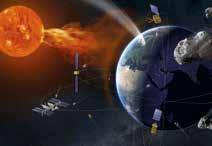
IRIS2 (Infrastructure for Resilience, Interconnectivity and Security by Satellite) is a multi-orbital constellation that will combine the benefits offered by Low Earth (LEO), Geostationary (GEO), and Medium Earth Orbit (MEO) satellites. It will deliver enhanced communication capacities to governmental users, businesses, while ensuring high-speed internet broadband to cope with connectivity dead zones. The system will support a large variety of governmental applications in domains such as border surveillance or crisis management and humanitarian aid. IRIS2’s initial services are to be delivered in 2024 and reach full operational capability by 2027.
Space Situational Awareness (SSA) is an essential component of the EU Space Programme and plays a key role in ensuring the safety and security of the European economies, societies and citizens who rely on space-based applications for communication, navigation and observation. One of the core functions of SSA is to mitigate the risk of a collision between satellites and space debris, a process called Space Surveillance and Tracking (SST). An SST system uses a network of ground- and spacebased sensors and other infrastructure to survey, track and protect space objects orbiting Earth. EUSPA is responsible for the SST front desk operations since July 2023.
A missing link in the contemporary debate on
by Dr Stefan Selke, Professor of Societal Change and Founder of the Public Science Lab, University of Furtwangen, Germany

Imaginations about the new space age1 are increasingly finding a ready-to-receive audience. Corresponding future narratives exist in the form of visions, progress stories, meta-analyses, political-normative models, media reports but also fictional representations. These narratives are associated with the expectations of a wide range of actors and stakeholders, mostly business and politics. This article therefore focuses on publics of contemporary societies.
The legitimisation of space exploration
In the debate, promises of progress are repeated with hypnotic redundancy, mostly in the form of an “exhibition of potential achievements”. However, one central aspect is usually a blind spot: while private space actors (SpaceX, Blue Origin, Axiom etc) are not dependent on societal legitimacy and acceptance, national (e.g. NASA) and international space agencies need broad and sustained support from society. This situation is particularly challenging for the European Space Agency (ESA) and its 22 member states. Therefore, future space exploration requires more than just a “return on investment” as a legitimising basis for taxpayers. The main reason: future generations will ask profound questions about the “why” of space exploration. And contemporary space agencies do not yet have adequate answers. These questions concern the elementary, yet neglected distinction between the usefulness and the public value of space exploration – use and value are not synonyms! This is particularly evident where an independent European path into space is being sought, e.g. in ESA’s current mission statement “Revolution Space”.2
European autonomy in space
In order to secure Europe’s autonomous path into space, a differentiated understanding of autonomy is needed. Therefore, a distinction must be made between operational, strategic and moral autonomy. This necessary distinction is a blind spot to date.
“ In recent decades, space flight has changed from a technical experiment to a political demonstration and eventually to a cultural symbol.”
Operational autonomy is quite trivial. It can be ensured with technological innovations and political alliances. These efforts are held together by the rhetoric of usefulness: benefits, spinoff, output, return on investment. The crucial point is that these arguments are only attractive from the (more or less) selfreferential internal perspective of the space agencies and their direct business partners. What is ignored is that they hardly generate any public resonance in society at large. This is precisely why strategic and moral autonomy are nontrivial challenges. To achieve the goal of comprehensive European autonomy in space, findings from similar fields of research should be considered: the necessary distinction be -

tween benefits and values also arises in the context of the public use of scientific knowledge or in the implementation of artificial intelligence in everyday life. The basic insight here is that a pure focus on usefulness generates unwanted public reactions and conceptional pathologies. Economisation, privatisation and commodification obscure the public reception of any given innovation. However, this perspective is essential for sustainable societal legitimation.
The focus on (one-dimensional) operational functions and innovations leads to a narrowing of perspective. Here, the means (i.e. the technical tools) come to the fore and the goals recede into the background. However, the (multidimensional) public value will only become visible when the end-means relationship is reversed.
This necessary change of perspective requires a deeper reflection of the epistemological status of space exploration. In recent decades, space flight has changed from a technical experiment to a political demonstration and eventually to a cultural symbol. This is also associated with changes in the expectations of the public. As a next step, space exploration could be regarded as a catalyst for new collective orders. However, the shift from traditional world orders to an “explorative modernity” in the context of a transformative-civilisational meta-perspective is still a research gap.
As a prerequisite for this, space agencies should also define themselves as future agencies. On this basis, they could partici-
pate in the shift from a collective survival design (in the context of regressive fear-driven adaptation narratives) to a universal world design (in the context of progressive narratives of departure). In a nutshell, this includes the development of new central social concepts (beyond technological progress), the promotion of new cultural orders and symbols as well as the collaborative formulation of a progressive “deep story” as the basis for a coherent, planetarily accepted narrative of meaning for human existence in the 21st century.
It has been done before: in the mid-1980s, the US National “Commission on Space” published the report “Pioneering the Space Frontier”. The result is still unique because the commission not only developed technological scenarios, but also named “civilisational values” for space programmes. The introduction, “Declaration for Space”, addressed the human dimension of space exploration. On the one hand, the report attempted to predict the future, but on the other, it was already designing it. A best-practice example of what is called “transformation by design” nowadays.
To reach this level, space agencies would have to focus less on aspects of operational autonomy. Instead, they could focus on their responsibility to dynamically stabilise societies and the planet in transition. In the context of European history and the European canon of values, it would then be possible to speak authentically of strategic and moral autonomy.
Given the importance of the public perspective for a futureproof legitimisation of space exploration, it is surprising that space agencies do not have corresponding social science-oriented research departments. It is precisely through the application of innovative methods of collaborative transformation research (e.g. a so-called “public vision assessment”) that a multidimensional understanding of European autonomy – this time considering the public value of space exploration – could be created and consolidated. Such an approach would not only provide answers to all future generations about the societal implications of space flight but would actually initiate a “revolution”. ■

https://www.public-science-lab.de/

is Professor of Societal Change at the University of Furtwangen in Germany. Furthermore, he is a research professor for “Transformative and Public Science” and founder of the Public Science Lab. Dr Selke studied Aviation and Aerospace Technology, later sociology, philosophy, anthropology, and Portuguese literature. His current research interests are digital transformation, artificial intelligence, social utopia, and new space exploration. stefan.selke@hs-furtwangen.de
by Dr Antje Nötzold, Senior Research Associate, Department of International Politics, Chemnitz University of Technology, Germany
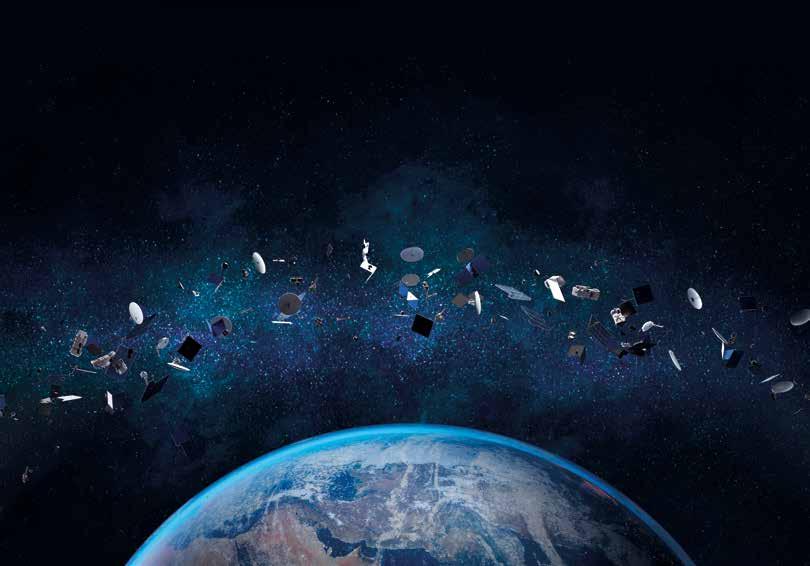
After land, sea and air, space has become the fourth dimension of human civilisation and a day without space is virtually impossible. Space-based systems are not only militarily essential, of considerable economic value and therefore of strategic importance for every state in the world, they are now indispensable for the daily life of modern societies. So, an increasing number of players – states, companies and private individuals – are aiming for space while Earth’s orbit is not infinite, but rather more and more crowded.
Cluttered with satellites…
While coveted space for new satellites is becoming scarce in the Geostationary Orbit (GEO – 35,786km altitude), the Low Earth Orbit (LEO – 100-2,000km) is heading towards overcrowding. With around 1,400 functional satellites in 2016, this number has increased to approximately 9,500 and is constantly growing. Currently, 20 to 50 satellites are launched per week, with the rapidly growing NewSpace sector of commercial space-based services, particularly in communications and earth observation. Starlink already accounts for most active satellites, with over 6000, and is set to grow to 42,000. In conjunction with other commercial providers, the International Telecommunication Union (ITU) has received requests for up to 70,000 new satellites by the year 2030. Concurrently, countries such as the US (Starshield), China, Taiwan, and Europe (IRIS²) are also planning to set up their own mega-constellations to reduce strategic vulnerability and dependence on commercial players, especially Starlink.
In addition to the soon-to-be tens of thousands of satellites, near-Earth space is overcrowded with man-made junk. Space debris is defined as any human-made object in orbit that no longer serves a useful purpose, created by the loss of function, collision or explosion of formerly functional space objects. This includes old rockets, spacecraft fragments, dead satellites and pieces from collisions. Although over time, these objects descend into lower orbits and enter the Earth's atmosphere, the problem will not solve itself. At an orbital altitude of 800km, objects are expected to remain in orbit for up to 150 years before re-entering the atmosphere. In addition to around 36,000 recorded parts larger than 10cm in diameter, statistical models estimate that there are around one million pieces of debris between 1 and 10cm, and 130 million fragments between 1mm and 1cm travelling through space at a speed of several kilometres per second. This means that burnt-out rockets as big as school buses orbit at 10 km/s on average, with no brakes or steering wheel. And while we are not able to track objects smaller than 10cm with existing technology, a piece of 1cm in diameter already has the kinetic energy of a hand grenade.
85% of the debris is in LEO, where the ever-increasing number of satellites, with their inevitable failures and technical faults, exponentially increases the risk of further space debris, as does the competition between the leading space powers
to expand counterspace capabilities to temporarily or permanently disable or destroy their rivals' satellites. In particular, anti-satellite (ASAT) missile tests have a massive impact. The destruction of the Chinese satellite Fengyun 1C in 2007 generated around 3,500 known pieces of debris, with threequarters still in orbit, and the debris cloud from Russia's ASAT test in November 2021 put the International Space Station (ISS) on alert several times.
Non-kinetic attacks using lasers or electromagnetic pulses can also render satellites inoperable and thus pose a threat to other satellites. In 2009, two satellites collided for the first time when the defunct Russian military satellite Kosmos 2251 hit the US communications satellite Iridium 33. Between December 2022 and May 2023, Starlink satellites performed 25,000 collision avoidance maneuvers. This equates to an average of 137 maneuvres per day per satellite. However, not all satellites are capable of this, so NASA was only able to observe a nearcollision when an inactive Russian Kosmos satellite missed the US Earth observation satellite TIMED by less than 10 metres on 28 February 2024.
Consequently, the probability of further collisions is high, with each collision leading to new space debris, which in turn jeopardizes other satellites. This could lead to the Kessler syndrome, which is a cascading increase in the number of small objects in space debris due to random collisions. Once initiated, the cascade would affect all satellites and render the entire orbital altitude unusable. So, mathematically, the current situation in LEO is already a ticking time bomb. Therefore, the implementation of active international Space Traffic Management (STM) is a pressing necessity, which must encompass three fundamental elements.
“ The EU proposal for an International Code of Conduct for Outer Space Activities should be pursued with greater urgencys.”
Firstly, the initial step in ensuring the safety of satellites is to gain a fundamental understanding of the situation in space. International exchange, particularly with the US, which continues to possess the most comprehensive SSA capabilities, remains crucial. Nevertheless, it is essential to build up independent capabilities. The implementation of the EU Space Surveillance and Tracking (SST) capability is an important approach to bundling and linking national capacities, which should be further expanded in terms of technical capabilities, e.g. supplementing the currently purely earth-based sensors with space-based reconnaissance.
Secondly, to prevent further space debris and damage to satellites, it is essential to establish and enforce basic “traffic rules” and standards. Satellites – both governmental and commercial – will increasingly not only possess high maneuvrability, but also other systems such as grappling arms, which can be employed for unfriendly behaviour and the infliction of harm upon other satellites. Thus, the EU proposal for an International Code of Conduct for Outer Space Activities should be pursued with greater urgency. Furthermore, the rapidly growing proportion of – sometimes simply produced – smallsats requires a definition of minimum standards for design and technology, such as maneuvrability or de-orbiting rules, to prevent them becoming or generating further debris. Today, not even all European spacefaring nations, such as Germany, have a national space law to define this. Furthermore, the EU space law, which was announced for early 2024, is unfortunately delayed.
Finally, it is of paramount importance to actively remove debris. A multitude of possibilities and projects are pursued and already well advanced in research and development, such as robotic arms, lasers or collecting nets. However, two significant obstacles to the de-pollution of space remain. First, these options have a dual-use character and could be used for military purposes against an opponent’s space assets. Consequently, consensus is needed on the definition of a space weapon relating to unfriendly behaviour in space. Second, who is going to pay the bill of active debris removal?
These tasks are challenging and require a common ground between the growing number of actors in space. Nevertheless, the issues must be addressed at the political level in a timely manner if space sustainability is to be secured and space usage made available to all members of the human race and future generations. ■
© Daniel Martin-Findeklee
PD Dr Antje Nötzold

is a Senior Research Associate and Lecturer at the Chair of International Politics at Chemnitz University of Technology. She is also a Non-Resident Fellow at the American German Institute (AGI) at Johns Hopkins University, Washington DC, an Associate Fellow at the Center for Advanced Security, Strategic and Integration Studies (CASSIS) at the University of Bonn and a member of the SichTRaum (Security and Technology in Space) research network. Dr Nötzold has published widely on astropolitics, strategic competition, space governance, conflicts and warfare in space, amongst others.

A story from Spain, by Nannette Cazaubon, Paris
Against the background of an increasingly tense geopolitical situation, accentuated by Russia’s ongoing war against Ukraine, geospatial intelligence has become highly important in the field of security and defence. In this context, the European Union Satellite Centre (SatCen) in Spain, enabling rapid and reliable analysis of satellite data in an era of information overload and distortion, has gained importance and visibility in recent years.
We decided to present to our readers the fascinating work of this agency, generally unknown by the broad public. Together with Editor-in-Chief Hartmut Bühl, I travelled to Torrejón de Ardoz, near Madrid, to visit SatCen and discuss our questions with the Centre’s highly qualified experts, who had kindly invited us.
(4 April 2024) After having crossed the huge Torrejón military air base where SatCen is located, we arrive at the headquarters’ modern white building. Theodora Filip, Communications Officer, gives us a first quick tour through the facilities before our meeting with SatCen’s Director, Ambassador Sorin Ducaru, starts. During our interview (see page 34), Director Ducaru introduces SatCen’s history, its mission and specificities to us.
SatCen at a glance
The purpose of SatCen is to support decision-making and actions in the field of security and defense, including support for civilian missions (e.g. humanitarian aid, disaster relief, emergency management) and military operations, thanks to geospatial intelligence (GEOINT) resulting from the exploitation of satellite and aerial images and associated services.
GEOINT unites several disciplines such as mapping, map making, imagery analysis and imagery intelligence. The principle is to combine all available data around a geographical location
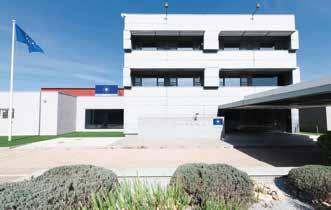
on Earth and then exploit it to prepare products that can be easily used by planners, rescue workers and decision-makers. Under the lead of the EU High Representative, the Centre delivers products and services to Member States, the European External Action Service (EEAS), and other EU agencies or international organisations.
Supplied by private service providers, as well as the “Sentinel” satellite constellation of the European Earth Observation Programme Copernicus and government satellites in five EU Member States, over 80% of the satellite data used at SatCen comes from European space assets (compared to only 5% around 2010). Having started in 1992 as a sort of demonstration project under the Western European Union (WEU), with only a small team, the EU agency today counts five divisions and a staff of 160 experienced imagery analysts, geospatial specialists and supporting personnel. The agency runs with an annual budget of ca €16m from Member States, about €11m from SatCen’s analysis for EU missions, operations and international partners, as well as €11m from the EC for multiannual cooperation projects like Copernicus.
Operations – working at high tempo
We learn details about operational aspects during our meeting with Álvaro Ruiz who heads the Operations division, the operational core of SatCen, where imagery analysts exploit Earth observation data to prepare analysis and geospatial intelligence products.
“Everything starts with a question, or more precisely with many questions”, Mr Ruiz tells us. These requests from the EEAS or Member States for the analysis of satellite information on different areas in the world are first prioritised at the EU Intelligence and Situation Centre (EU INTCEN), which is part of the Single Intelligence Analysis Capacity (SIAC) combining civilian and military intelligence.

A collective intelligence plan lasting one year is delivered to SatCen at the start of each year. However, as explained Mr Ruiz, the whole plan can suddenly become obsolete, as was the case in February 2022, when Russia invaded Ukraine. “We then started with a new plan given the new geopolitical situation”, he says.
Mr Ruiz continues that the spacious operations room is at the core of the Centre, where the highly qualified analysts (half of them with a military background, the others coming from the civil sector) sit in front of large screens showing satellite or aerial images. They work in nine specialised teams of seven or eight, which “is the perfect size for high performance in a very high tempo”, as Mr Ruiz explains. The specialists work on weekly plans: on Monday they receive the requests from Brussels and deliver all the analysis before the end of the week. Focused on results, the division produces 120 reports per week (over 6000 per year).
The Head of the IT division, Alexis Letulier, joins us and gives us more details on the technical solutions and IT tools developed by SatCen.
He highlights the important change in the communication with SatCen’s end-users since 2021. Through a new secured IT platform classified “EU secret” using automated solutions and reconnaissance tools entirely developed by SatCen, the accredited users now have access to the totality of SatCen’s data and can follow the workflow in real-time and download what they need. “This means that we advanced from a time-consuming document-based concept to an interactive service”, Mr Letulier summarises.
The use of Artificial Intelligence (AI) also gains time. Mr Letulier gives the example of a satellite image showing the sea: while without AI an analyst must zoom on every cm of the image to see details, AI can automatically detect a small boat with migrants in the middle of the sea. “However, AI is not 100% reliable and the work of the highly qualified analysts is necessary to interpretate the images,” the Head of IT adds.
SatCen not only provides geospatial intelligence and products, it also develops new solutions in its Research, Tech -

nology, Development and Innovation (RTDI) unit, and offers training.
At the end of our day at SatCen, we meet the Head of Capability Development, Andrea Patrono, who gives us more details on the variety of training courses, lasting generally one or two weeks. Besides basic courses such as data processing or imagery analysis in areas related to defence and security, there are, amongst others, specialised courses on geospatial intelligence, Synthetic Aperture Radar (SAR) imagery, or imagery analysis training for the interpretation of industrial installations or nuclear sites.
The demand for the training courses is high. They address SatCen personnel but also external experts from Member States or international organisations, which “is a fantastic instrument to harmonise the process of the exploitation of satellite and aerial analysis”, Mr Patrono concludes.
SatCen’s future – entering a new phase
Navy Captain Louis Tillier, Deputy-Director at the time of our visit, joins us in the meeting room for a coffee. With his take-over as SatCen’s new Director on 1 June 2024, the Centre will enter a new stage, he explains. “After Ambassador Ducaru’s excellent work for the visibility of SatCen, the future challenge will now be to align the Centre with the renewed EU ambitions in security and defence, following the war in Ukraine and on basis of the Strategic Compass”, the future Director says.
Currently, the demands for geospatial intelligence and training are much higher than SatCen can answer. But the Centre, described by EU High Representative Josep Borrell as “the European Union's eyes in the sky (in orbit) and a very important part of the EU's security”, clearly has come into the focus of political leaders. The enlargement of SatCen’s headquarters and the recent strong political backing from the Member States’ political leaders for SatCen’s strengthening and further development reflect this situation well.
We will continue to follow, with our magazine, SatCen’s future developments. ■


Web: www.satcen.europa.eu
SatCen Annual report: https://bit.ly/3ReZKgU
➭ See interview with Director Sorin Ducaru page 34


Interview with Sorin Ducaru, Director of SatCen, Torrejón
The European: Ambassador, the European Union (EU) agency you are heading is recognised as a unique European security provider through its geospatial intelligence support. The importance of SatCen was highlighted in the 2022 Strategic Compass and more recently in the new EU Space Strategy for Security and Defence. What is the specificity of SatCen compared with other space institutions, such as the EU Agency for the Space Programme (EUSPA) or the European Space Agency (ESA)?
Sorin Ducaru: Among the larger ecosystem of entities dealing with space in the EU environment, SatCen is the only institution that links the space domain with security and defence. ESA is not an EU agency but an international organisation doing research and innovation, for exclusively peaceful purposes, for its 22 member states. And EUSPA – an EU agency like SatCen – implements and runs the EU Space Programme for civilian purposes. While EUSPA is under the supervision of the European Commission, the governance of SatCen is under the Council of the EU. This means that SatCen belongs to the EU Member States (MS) which provide the funding and have access to all our analysis products and services.
The European: What is the reason for this difference in governance?
S. Ducaru: The difference lies in the fact that the Commission, under the Lisbon Treaty, is not supposed to deal with security and defence policy. This topic belongs to the EU MS under the Common Foreign and Security Policy (CFSP). In 1992, when SatCen was created, it was a Western European Union (WEU) agency, as security and defence was not part of the European community architecture. Only 10 years later did it became an EU agency, as security and defence was integrated under the second pillar.
The European: Do you also deal with civilian purposes? And how does the cooperation with other agencies and institutions work?
S. Ducaru: We strongly support civilian purposes, such as the management of climate change effects, disaster relief or humanitarian aid, and we cooperate with international organisations such as the United Nations (UN), the Organisation for the Prohibition of Chemical Weapons (OPCW) or the OSCE. We work closely with ESA and EUSPA, but also with other EU agencies, such as the Eu-

ropean Defence Agency (EDA) or the European Border and Coast Guard Agency Frontex, which use our information and analysis for their missions.
The European: SatCen delivers geospatial intelligence support to various civilian and military EU missions and operations. Could you name a few?
S. Ducaru: It is important to underline the high operational character of SatCen which enables the agency to support all kinds of missions and operations. To name a few: we have been supporting the counter-piracy naval operation ATALANTA off the Horn of Africa for a long time, and we have been intensively supporting IRINI, a military naval operation aiming at enforcing the arms embargo in Libya. The newest example is our support to the military operation ASPIDES in the Red Sea. We also supported the civilian mission in Georgia and the advisory mission for civilian security reform in Ukraine before the Russian invasion.
The European: Are the images and data you collect from space taken from European assets, or do you depend on external, such as US, geospatial intelligence?
S. Ducaru: Reaching independence in this field was the idea of this centre. In 1991, during the Gulf war, EU Member States decided to create SatCen with the objective of setting up the capability to analyse from space what is happening on the ground. At that time, Europeans were totally reliant on the information Americans gave them from time to time.
The European: Ambassador, you have been heading SatCen for over five years now, during your mandate the Centre celebrated its 30th anniversary and inaugurated its new, more spacious headquarters. On 1st June you will leave SatCen and hand over to your successor, Navy Captain Louis Tillier, who is currently your Deputy. How do you see SatCen’s future and what is your personal wish for the Centre?
S. Ducaru: I am convinced that there is much history to be written in the future of SatCen, based on an increasing need and user demand, a growing level of ambition of the EU in the domain of space security and defence, and the fast technological development in the space and IT domain. As an ambassador with a 25-year diplomatic career, I wanted to make sure that the value of the Centre, which was not well known before, is recognised by political leaders. It was therefore a success for me when EU ministers, gathering for a board meeting at SatCen last year, highlighted the importance of the Centre and provided the political guidance for its future development. Personally, what is close to my heart is that the creative and innovative spirit of the Centre, where people easily come together and share their ideas, is preserved in the future. ■
The interview was held on 4th April 2024 at SatCen headquarters in Torrejón de Ardoz, Spain.
by Hartmut Bühl, Paris
The European Space Operations Centre (ESOC) is the European Space Agency’s (ESA) control centre and Europe's centre of excellence for satellite operations. ESOC has been responsible for the operation of all ESA satellites and the necessary global network of ground stations since 1967. To date, the centre has operationally supported over 60 ESA satellites as well as numerous missions from other national and international organisations.
Thanks to its nearly 300 employees and 600 contractors, ESOC can simultaneously control over 15 satellites at the same time and additional satellites in the early launch phase (LEOP) and carry out world-renowned rescue operations.
ESOC hosts the control centre of the worldwide network of ground stations which provides links between ESOC and the satellites in orbit. Tracking is provided through all phases of a mission, from the critical Launch and Early Orbit Phase (LEOP) through routine operations, special manoeuvres or flybys and ultimately through deorbiting and safe disposal. Furthermore, ESTRACK can track rockets flying from Kourou in French Guiana.
This network consists of five large multi-purpose stations in Kourou (French Guiana), Perth (Australia), Redu (Belgium), Maspalomas and Villafranca (Spain) and a polar station in Kiruna (Sweden). ESA's interplanetary missions are supported by antennas in New Norcia (Australia). Furthermore, ESA also uses ground stations in collaboration with other space organisations.
Mission preparation and execution
Mission analysis is a flight dynamics task at ESOC. The centre is responsible for determining, predicting and controlling the trajectory of a satellite as well as its orientation in space for selecting the optimal orbit. In the early planning phase of a mission, ESOC experts propose the choice of launch vehicles, the use of ground stations, the planning of complex manoeuvres and the duration of all types of missions from earth observation to astronomy and planetary science to navigation. ESOC provides important information for the industrial consortium responsible for building the satellite, since the selected trajectory and the resulting operational concept will influence the design of a satellite. Immediately after the satellite is separated from the launch vehicle, the ESOC main control room in the headquarters in Darmstadt takes control of it. All manoeuvres that bring the satellite into its final orbit are carried out here and the control centre is
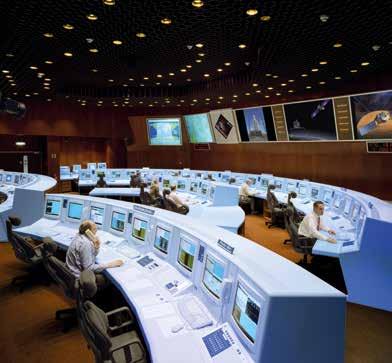
The Main Control Room (MCR) is a core element of ESA’s general-purpose ESA Operations Control Centre (OCC). Within the OCC, some different functions are handled from other separate, dedicated rooms such as the Flight Dynamics Room (FDR), the Ground Configuration Control Room, and the Dedicated Control Room (DCR)
in constant contact with the entire ESA ground station network. Once the satellite has reached its routine trajectory, a dedicated sub-control room takes over control.
Innovative technology transfer is part of the ESA business initiative. For that, an information and startup centre for satellite navigation has been established in the ESOC environment, called Centre for Satellite Applications Hessen (cesah). cesah is supported by the state of Hesse, the city of Darmstadt, the Technical University and the Darmstadt University of Applied Sciences but also by large companies in the region. cesah supports young companies and startups in the development, implementation and market launch of new products and services related to satellite navigation. ■

https://esoc.esa.int/

The need for strong space infrastructure and capabilities
by Sinéad O’Sullivan, Research Fellow, US Center for Climate and Security, Washington D.C.
In an era marked by geopolitical shifts and evolving alliances, the notion of western sovereignty in space emerges as a paramount expression of a need for heightened security and resiliency. Led by the United States, western nations recognize the imperative to assert their independence and strengthen their aerospace and defense capabilities. Furthermore, recent events, including the conflict in Ukraine and the Middle East, highlight the need for the west to enhance its resilience and self-reliance in the face of geopolitical tensions with a rising east.
The west, led by prominent space agencies such as NASA and ESA, as well as a robust private space economy backed by strong capital markets, has long been at the forefront of space exploration and innovation. From launching satellites for communication and navigation to conducting groundbreaking scientific research on distant planets, western nations have demonstrated their increasing capacity in harnessing the potential of outer space.
The changing landscape of space activities
However, the landscape of space activities is rapidly changing. The emergence of new spacefaring nations and the proliferation of commercial space ventures have ushered in a new era of competition and collaboration. While cooperation in space exploration and utilization is crucial, ensuring western sovereignty in space is paramount to safeguarding national interests and maintaining strategic autonomy.
At the heart of western sovereignty in space lies the need for strong space infrastructure and capabilities. For example, satellite constellations play a pivotal role in modern society, supporting vital functions such as communication, navigation, weather forecasting, and surveillance. Securing these space assets against potential threats, including cyber-attacks, space debris, and hostile actions, is imperative to preserving western interests and maintaining a competitive edge.
Furthermore, the pursuit of space exploration serves strategic and geopolitical objectives. The ability to project power and influence
Sinéad O'Sullivan
beyond Earth's atmosphere has profound implications for national security and defense. Space-based assets provide critical capabilities for intelligence gathering, surveillance, reconnaissance, and early warning systems, enabling western nations to deter potential adversaries and respond effectively to emerging threats.
Countering emerging challenges in space
More recently, concerns have been raised about the militarization and weaponization of space, as well as the need for norms and regulations to prevent conflicts and ensure responsible behavior among spacefaring nations. Western countries have a vested interest in promoting international cooperation and diplomacy in space governance, while also maintaining the capability to protect their interests and defend against potential adversaries.
To uphold western sovereignty in space, it is essential to enhance collaboration and coordination among like-minded nations. Initiatives such as the Artemis Accords, led by NASA, aim to establish principles for the peaceful exploration and sustainable utilization of the moon and other celestial bodies, while also ensuring transparency, interoperability, and the protection of heritage sites and scientific assets.
“ Western countries must reaffirm their commitment to maintaining leadership and autonomy in space exploration and utilization.”
Furthermore, alliances and partnerships between western countries and their allies, such as NATO, offer opportunities to strengthen collective security and resilience in the face of emerging challenges in space. By leveraging each other's expertise, capabilities, and resources, western nations can better address common threats and promote stability and cooperation in the space domain.

© Matthew Guillory
is a Research Fellow at the US Center for Climate and Security. She is also a Senior Researcher at Harvard Business School and teaches at the Faculty of Aerospace Engineering of the Illinois Institute of Technology. She holds a master's of Aerospace Engineering from the Georgia Institute of Technology and a master's of Business Administration from Harvard Business School.
Ms O’Sullivan’s work focuses on the intersection of technology, geopolitics and complexity science.
Western sovereignty in space matters not only for advancing scientific knowledge and technological innovation but also for safeguarding national security, economic prosperity, and strategic interests. As the space industry continues to evolve and expand, western countries must reaffirm their commitment to maintaining leadership and autonomy in space exploration and utilization. By investing in space infrastructure, fostering innovation, promoting international cooperation, and upholding norms and regulations, the western world can secure its position as a leading force in the final frontier of human endeavor. ■
by Hartmut Bühl, Paris
The American National Aeronautics and Space Administration (NASA) is the result of the space race that emerged at the end of the 1950s. The Congress of the United States saw the successful launch of Sputnik 1 – the first ever artificial satellite sent into orbit by the Soviet Union in 1957 – as a threat to national security and feared for the country’s reputation as a technological leader in the world.
The so-called “Sputnik crisis” triggered the creation of NASA on 29 July 1958 as an independent agency of the US federal government, responsible for the civil space programme, aeronautics and space research. NASA began its work on 1 October 1958. Employing today more than 17,000 people, NASA has led most

An example for cooperation is the US/EU agreement from 2004 on the promotion, provision and use of the European Galileo and the US operated Global Positioning System (GPS) satellite-based navigation systems and related application. The parties expressed their intention to work together to promote and facilitate the use of these signals, services and equipment for peaceful civil, commercial and scientific purposes, and to further mutual security interests.
Another telling example are the Artemis Accords, in line with the NASA lead Artemis programme, which includes sending the first woman and next man to the surface of the moon and build the


of America's space exploration programmes, including the first human spaceflight programmes Mercury and Gemini, the Apollo Moon landing missions, the Skylab space station, and the Space Shuttles. The International Space Station (ISS) along with the Commercial Crew Program are supported by NASA which also oversees the development of the Orion spacecraft and the Space Launch System for the lunar Artemis programme. However, there were also setbacks, such as the two shuttle explosions of Challenger (1986) and Columbia (2003), making NASA loose two teams of seven astronauts each.
While there is competition among historic and emerging space powers, there also exists a range of cooperation projects among them, e.g. common projects like the ISS, the use of launchers of other powers, or the exchange of information. The European Space Agency (ESA) and NASA have a strong cooperation on space sciences.
foundation for crewed missions to Mars. Established in 2020, the accords were first signed by eight countries: Australia, Canada, Italy, Japan, Luxembourg, United Arab Emirates, the UK and the US. On 15 May 2024, with Lithuania signing the accord, the signatories reached 40, which is good news for a long-term and peaceful presence of deep space exploration for the benefit of humanity.
In April 2024, NASA released the first part of its new integrated Space Sustainability Strategy to address a rapidly changing space operating environment (e.g. Earth’s orbit overcrowded with satellites and space debris) to ensure its preservation for generations to come. While the first volume of the strategy focuses on sustainability in Earth’s orbit, NASA plans to produce additional volumes focusing on other domains. ■

www.nasa.gov
by Hideshi Tokuchi, President of
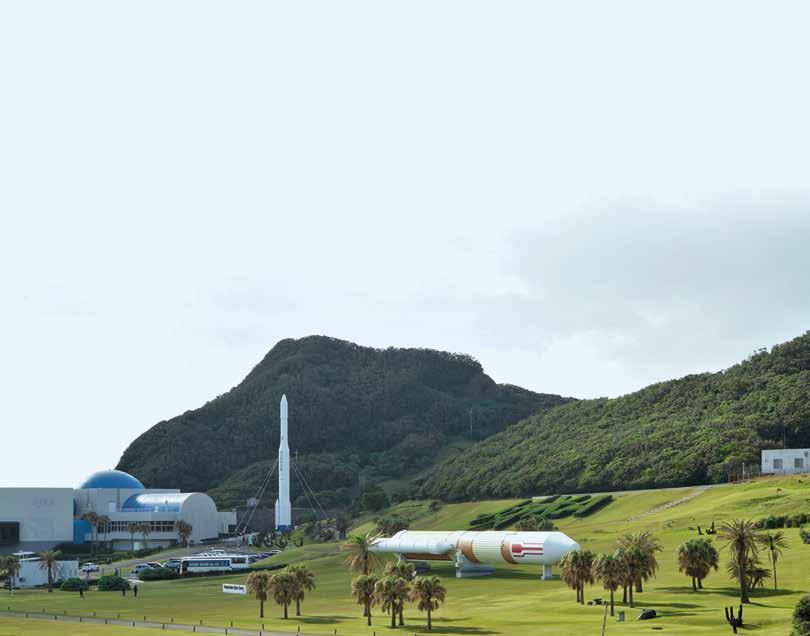
Space is important not only for scientific research and economy but also for international security. Historically, space was regulated by international arms control agreements earlier than nuclear weapons or cyberspace. It only took ten years to establish the Outer Space Treaty after the first successful launch of an artificial satellite in 1957. This was probably possible due to the scarcity of actors in space development in the early days of the post-second world war era.
Today’s situation is different. More than 50 countries have artificial satellites. Space is used for civilian and military purposes, and both uses are inseparably connected. The critical importance of space is clear in the Russia-Ukraine war. There is a view that even today wars are decided by guns and munitions, but space is a force multiplier, to say the least. Space capabilities make much difference as shown by the effects of satellite imagery, GPS data and Starlink-guided drones, for example. Space has become “a decisive domain”.
Great power competition between the US and China has set the basic tone of today’s international relations. It has a grave impact on outer space, too. The two powers were cooperating
in space for some time after the end of the cold war. The US used Chinese rockets to launch its space assets into orbit, but those good old days are gone.
The US remains the leader...
While the funding, the technological level and the innovative spirit of the US remain overwhelming, China is rapidly catching up in its space capabilities.
China’s People’s Liberation Army plays a pivotal role in its space activities. China’s space policy has a long history dating back to Mao Zedong’s “two bombs and one satellite” policy motivated by the Korean war. While China was the fifth country in artificial satellite launching, it was the third to achieve manned space flight with its own rocket. It launched a quantum science satellite called Mozi for quantum-encoded communications in 2016, which was “a 21st century Sputnik moment”. China, with its own space station and positioning system, recorded the highest number of rocket launches worldwide in 2018.
... but China has great ambitions
China prioritises the military use of space. It already conducted an ASAT (anti-satellite weapons) test in 2007. The destruction
created more than 3,000 pieces of space debris, much of which will remain in orbit for decades and pose a serious threat to other space objects. The US advantage in space development and activities will remain unchanged for the time being, but we should not be complacent about it as China is trying to become a space power to achieve its dream of making China stronger. Chinese attempts high above the Earth will have a grave impact on our daily life and national and international security on Earth. As the serious nature of the issue is not easy to understand without scientific knowledge, it is important to remain vigilant regarding Chinese space activity, to share the information with the public in order to maintain the rules-based order on Earth and ensure stable use of space for the prosperity of mankind.
Japan’s National Security Strategy (NSS) and National Defense Strategy (NDS) set forth ways and means for Japan to survive in the age of the great power competition.
The NSS states, “To ensure safe and stable utilisation of space, (…) Japan will strengthen its response capabilities in the field of space security,” and “Japan will drive forward measures to capitalise on Japan’s overall space-related capabilities in the field of security.” Based on this recognition, the NSS refers to various issues including Space Situational Awareness (SSA), space debris and rule-making as examples of cooperation with like-minded countries. The NDS states, “Since the domains of space, cyber, and electromagnetic spectrum are the basic infrastructure for the people’s lives as well as being vitally important for the defence of Japan to carry out cross-domain operations, Japan will reinforce capabilities across the whole government.”
“ While the funding, the technological level and the innovative spirit of the US remain overwhelming, China is rapidly catching up in its space capabilities.”
In accordance with the NSS, the Government of Japan established its Space Security Initiative (SSI) in June 2023 to set the vision for the basis of space security over the next decade. Based on the recognition that the use of space is directly linked to terrestrial military superiority and that threats in space are growing rapidly, the SSI defines Japan’s space security objective “to promote the peace and prosperity of Japan and the safety and security of our citizens through outer space, together with our ally, like-minded countries, and others to maintain the stable use of and free access to outer space.”
The SSI has two types of space security in it: “security from space” and “security in space.” The former is about using space capability for national security, and the latter is about defending space capability against growing threats and risks in space. As Japan recognises that space has become an arena of intensifying geopolitical competition, the SSI declares Japan’s will to strengthen cooperation with its allies and likeminded countries, while promoting the unified efforts of its relevant ministries and agencies to ensure the two types of space security.
As both Japan and Europe have been trying to enhance the rules-based international order, space security will be a new horizon for their cooperation. Article 16 of the Japan-EU Strategic Partnership Agreement includes the “security aspect of space activities” in the menu of outer space cooperation. The Japan-EU Space Policy Dialogue has been held five times since 2014 to exchange information on the latest space policies on each side, foster mutual trust and discuss space cooperation. The Japan-NATO Individually Tailored Partnership Programme for 2023–2026 includes space security as one of the 16 goals, and it is expected to promote dialogue and practical cooperation on space security accordingly. Europe is competitive in space development as it shares human resources and funding through the European Space Agency (ESA). It is a great advantage of European teamwork whereas Japan lacks funding, but its technological capabilities can be underestimated. It is important to generate synergy on both sides, capitalising on the recent momentum for cooperation.
Both sides are expected to work together to enhance Space Situational Awareness (SSA), to address space debris and to shape equitable international rules for the use of space. For this purpose, it is increasingly important for both sides to align with the US and to stay vigilant of the space activities of those who try to disrupt the rules-based international order, including China. ■
Prof Hideshi Tokuchi

has been the President of the Research Institute for Peace and Security (RIPS), an independent thinktank in Tokyo, since 2021. He teaches on securityrelated issues at several universities in Japan, including Sophia University in Tokyo. Hideshi Tokuchi earned his Bachelor of Laws from the University of Tokyo in 1979, and his Master of Arts in Law and Diplomacy from the Fletcher School of Law and Diplomacy in 1986. He served as the nation’s first Vice-Minister of Defence for International Affairs from 2014 to 2015 after completing several senior assignments in the Ministry of Defence. ©






Tby Luke Hally, Founding Director of Terra Nova Consultancy, Brussels
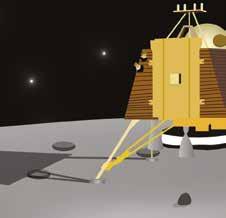

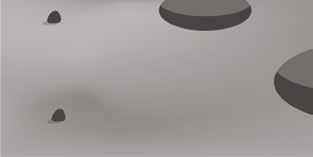
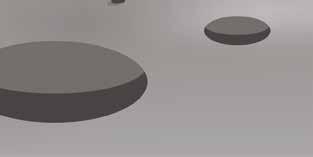
he security landscape of the 21st century is evolving rapidly, bringing new challenges that policymakers must swiftly address to adapt to the changing dynamics of the postunipolar world. Key factors driving this change include the emergence of artificial intelligence, cyber defence, drone technology, and, notably, space defence.
These new threats have emerged with unprecedented speed and intensity, demanding immediate action from EU policymakers to safeguard space security. To effectively counter these threats, the European Union must leverage all available resources and allied interests. Particularly, the EU should look towards cooperative efforts with like-minded partners, especially those in the east, to prepare and defend against the possibility of total war or hybrid warfare scenarios. The ongoing conflict in Ukraine heightens this sense of urgency.
A major concern in space security today is the progress of antisatellite (ASAT) weapons by certain states, notably Russia, seeking to disrupt European strategic capabilities. If armed with nuclear capabilities, this development could breach treaties like the Outer Space Treaty, endangering EU and allied military satellites and other space assets.
During the cold war, the US and the Soviet Union explored ASAT weapons, including nuclear tests. Russia's recent ASAT test on the Kosmos 1408 satellite in 2021 showcases its pursuit of such capabilities despite denying intentions for nucleararmed ASAT systems.
Compounding this threat is the rapid advancement of hypersonic missile systems, like Russia's A-235 anti-ballistic missile system, tested on Kosmos 1408. This system poses a dual threat due to its nuclear capabilities and purported hypersonic speed,
which is challenging to counter, especially in space, given the vast distances and atmospheric differences.

Various threats pose significant risks to vital systems crucial for European states, such as telecommunications, navigation, and missile defence. Of particular concern is Russia's reported development of a space-based nuclear anti-satellite weapon, heightening the peril to European space infrastructure. If unleashed, this weapon could indiscriminately endanger satellites, disrupting crucial services reliant on space infrastructure. Space debris emerging from any use of space-borne ordinance would endanger satellites and the International Space Station, heighten collision risks and threaten European space infrastructure. Risks include disrupted communications, impaired navigation systems, compromised weather forecasting, early warning system failure, and large economic impacts; these risks greatly jeopardise European security. Additionally, a nuclear explosion in space could produce a powerful electromagnetic pulse, damaging a wider array of satellite constellations. Russia's deployment of
“ By leveraging expertise and resources through international cooperation, Europe can strengthen its defence against space-based threats and foster a stable and secure space environment.”







anti-satellite weapons challenges efforts to limit offensive space weapons, emphasising the need for robust measures to protect and advance EU space assets.

Collaborative aims to counter these threats could be found in a variety of like-minded Asian partners, such as India and Japan for example.
The foundation for this cooperation is that India and Europe want to improve their political standing in space affairs. In this context, joint research and development of space assets can help them both reach their goals, such as India's Chandrayaan-3 moon landing. Issues of technology transfer and industrial cooperation, however, complicate the whole situation. But it is crucial to bear in mind that space represents a real opportunity for broadening the dialogue for mutual benefit and to recognise the value of deepening discussion, including a specific reflection on better integration of the competencies and experience of the Indian Space Research Organisation (ISRO) and the European Space Agency (ESA) at the political level. India would make for a viable partner in the rising global power tensions involving other large regional actors.
Exploring partnerships in space research, Japan, through its advanced capabilities via JAXA, can contribute significantly to joint space defence efforts. Potential collaboration with ESA and the European Defence Agency (EDA) could enhance satellite tech for communication, observation, navigation, and situational awareness, boosting overall defence capabilities.
Japan's evolving defence strategy, particularly in the space sector, aligns with its national strategy, which highlights three key areas: security from space, security in space, and support for the space industry. Notably, Japan aims to incorporate satellite constellations for monitoring potential targets and developing systems to detect and intercept hypersonic weapons, areas that align with EU interests and could foster cooperation. However, Japan faces challenges in implementing these ambitious plans due to technical expertise gaps and budget constraints. This presents an opportunity for collaboration between European and Japanese agencies to fill these gaps. Cooperation with Japan could be the optimal partnership for bolstering joint space operations tailored to the security needs of both parties. One area of shared interest is hypersonic interception, given the proximity of large regional adversaries and their hypersonic ballistic threat capabilities. The development of counter-hypersonic capabilities, like the Glide Phase Interceptor programme, demonstrates the potential for collaboration in addressing such threats. The H3 rocket also represents an example of an attractive collaborative model through its user-friendly design, reliability, and cost-effectiveness. Collaborative efforts in space transportation technology could further enhance both parties' capabilities. In conclusion, international cooperation, especially in space security rulemaking and ground-based security infrastructure development, is crucial for establishing a stable space environment. Collaborative projects such as hypersonic interception and advancements in space transportation technology present opportunities for fruitful partnerships between the EU and Japan, ultimately contributing to space security.
Europe faces unprecedented challenges in space security due to emerging threats like anti-satellite weaponry and hypersonic missile systems, notably from Russia. The potential emergent risks and consequences underscore the need for effective collaboration. Partnerships with like-minded Asian nations, such as India and Japan, offer valuable opportunities to enhance space defence capabilities. India's Chandrayaan-3 mission exemplifies potential joint ventures, while Japan's advanced capabilities align well with Europe's defensive focus. By leveraging expertise and resources through international cooperation, Europe can strengthen its defence against space-based threats and foster a stable and secure space environment. ■

is the founding Director of the Terra Nova Consultancy in Brussels. Of Irish origin, he is a security risk policy professional with expertise in human security, EU affairs and governance relations. Mr Hally’s core focus is on East Asian conflict analysis, climate threats, and European security policy with five years of security research experience at global and EU levels. His current research focuses on the EU security strategy in the Sahel, Ukraine and European nation-state shifts from neutrality to alignment.

More and more states are striving to master modern space technologies
by Debalina Ghoshal, Non-Resident Research Fellow, Council on International Policy, Canada / Correspondent for India and South Asia of this magazine, Calcutta
Developing states are focusing on satellite launch vehicles (SLVs) for the transport of satellites into space, mostly for commercial purposes. However, just as satellites are carried into space by SLVs, warheads are carried into space by ballistic missiles. As states like Iran and North Korea progress in their development of SLVs, it raises concerns about their possible military applications.
Proliferation concerns
Global concerns about the use of SLV technologies to carry ballistic missiles focus not only on security and threat perception but also on possible proliferation.
Many scholars and policy makers believe that Iran’s space technology programme is merely a cover for the development of long-range ballistic missile capabilities, like the Intercontinental Ballistic Missile (ICBM) that can reach targets beyond 5500kms. Iran has used its Qased launcher to launch Noor satellites into space. Critics consider that such developments violate the United Nations Security Council Resolution (UNSCR) 2231, that prohibits Iran from developing ballistic missile capabilities. In fact, the newer SLV technology uses solid propellant rocket motors, lightweight carbon casing and movable nozzles for thrust vector control.
In addition, SLVs are also becoming mobile instead of static, akin to those used for launching ballistic missiles. Mobile launchers can make SLVs survivable, even in crisis situations, but critics consider that this mobility has been developed for the purpose of launching ballistic missiles. In 2016, according to reports, Iran “successfully orbited satellites using its ICBM-class booster.” Reports also confirm that Iran’s space programme, that slowed down during the presidency of Hassan Rouhani, has gathered pace again under his successor, President Ebrahim Raisi.
North Korea is working on space-based surveillance systems and in 2023, it successfully placed the Malligyong-1 satellite into space and believes that this will strengthen its preparedness for war.
Debalina Ghoshal is a Non-Resident Research Fellow with the Council on International Policy, Canada. She is also the India correspondent for The European–Security and Defence Union magazine. Her work focuses on issues such as nuclear, missiles, missile defence and artillery.

The United States criticised this event on the grounds that such technologies could be used to develop International Ballistic Missile (ICBM) capabilities. North Korea has therefore faced international condemnation for the use of ballistic missile technologies in its space programme, thus violating UNSCRs 1718 and 1874. Reports confirm that Chollima-1 SLV “shares critical technologies with an ICBM” and when equipped with warheads and re-entry vehicles, could be used as a deterrent. It is generally assumed that the testing of Chollima-1 is a cover for testing the technological parameters of the Hwasong-15 and Hwasong-17 ballistic missiles.
The states that subscribe to the Hague Code of Conduct (HCoC), an organisation to strengthen transparency and confidence-building measures on missile capabilities, are expected to accede to and ratify the Outer Space Treaty (OST) of 1967. HCoC also includes a declaration regarding SLVs, including transparency building information that cover “policies, land (test) launch sites, as well as number and general class of space launch vehicle missions conducted in the previous year consistent with pre-launch notifications.”
HCoC could have a positive impact on member states by providing assistances to pursuing SLV technology in a way that could prevent it from developing ballistic missiles. States subscribing to the Convention are obliged to provide clear information on their ballistic missile and SLV policies.
Another noteworthy legal regime is the Registration Convention of 1975, whose main objective is to achieve transparency in space activities by making it mandatory to register spacelaunched objects. However, the Convention does not completely define the categories of space-objects to be registered, and they do not necessarily include space launchers. In fact, states like Iran have not registered their satellites under the Convention.
Despite the legal mechanisms available to prevent the proliferation of SLV technology into ballistic missile systems, they are not applicable to states that do not adhere to them. Also, states can always deny the connection between their SLV technology and ballistic missile development. And therein lies the real problem for security. ■

“I think that the European Union is entering today in a third moment of its construction. (…) The first was in 1957: common market with a limited number of European public policies. The second was the acceleration of economic integration through the single market and the single currency. And the third has started with the war in Ukraine, which will lead to the birth of a strong European security and defence pillar.”
Josep Borrell

by Dennis-P. Merklinghaus, Spokesperson for Aerospace, Defense, Security at Rohde & Schwarz, Munich
Space is globally recognised as being critical to economic success, national security and societal well-being. It is also a domain where confrontation with adversaries is more and more important, as an extension of the classical dimensions of warfare. This confrontation in space may take several forms, one of them being electronic warfare (EW).
NATO defines EW as “a military action that exploits electromagnetic energy, both actively and passively, to provide situational awareness and create offensive and defensive effects”. It is warfare within the electromagnetic spectrum (EMS) and involves the military use of electromagnetic energy to prevent or reduce an enemy’s effective use of the EMS while protecting its use for friendly forces.
Today’s EMS operations (EMSO) are very complex. Therefore, dominance through EMSO is a critical factor in determining a positive outcome for military operations.
Space EW is most commonly associated with satellites and their communications links – collectively known as satellite communications (SATCOM).
As today’s nations develop their space capabilities, spectrum superiority is just as important in space as it is for terrestrial operations. Space EW faces the significant challenge of operating throughout the entire electromagnetic spectrum under demanding environmental conditions. This in turn will drive the need for new EW techniques, technologies and systems that operate over a much wider spectrum and bandwidth.
As a communication market leader, Rohde & Schwarz provides indispensible technologies that apply to space EW, including COMINT and ELINT monitoring, signal analysis, interference hunting, handheld interference hunting, and more to capture long-term events.
Satellite monitoring (SATMON) software solutions from Rohde & Schwarz for remote spectrum monitoring (SPM) and signal analysis combine traditional spectrum analyzer functions, advanced signal detection and identification algorithms. Modern, adaptive GUIs make it easy to implement use cases, eg interference identification or SATCOM transponder analysis.
Rohde & Schwarz provides indispensable technologies that apply to space EW, including COMINT and ELINT monitoring, signal analysis, interference hunting, handheld interference hunting, and more to capture long-term events © Rohde & Schwarz
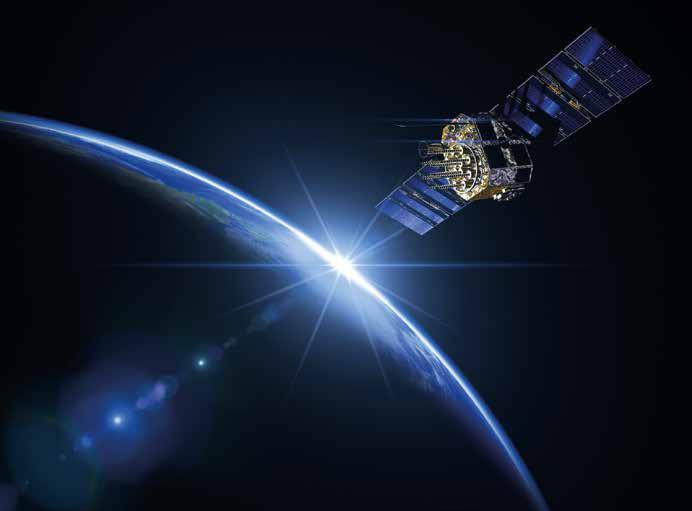
The Rohde & Schwarz remote SPM solution provides an interface for communicating with remote spectrum analyzers via remote connections; users can access their devices from anywhere in the world. This supports the monitoring of signals for one device at a time and for many different devices at once, also handling different users monitoring the same device. Both a standalone application and a server/client solution are supported.
Signal analyzers, or spectrum analyzers, from Rohde & Schwarz are useful in analyzing many aspects of space EW. Spectrum analyzers are wide bandwidth instruments used to acquire, analyze, display and demodulate radio frequency (RF) signals. They can give unique insights into:
► Tracking, logging, displaying and monitoring interference
► Jamming effects in time-frequency and amplitude domains simultaneously
► Demodulation of signals of interest
► Streaming interfaces to record signals of interest
► Autonomous monitoring of uplink and downlinks
These solutions provide wide dynamic ranges that enable the tracking of small signals and includes integrated preselection to reject out of band signals.
“ Space electronic warfare is a complex and emerging warfighting domain that presents a number of unique operational challenges.”
Signal generators, or more specifically RF vector signal generators (VSG), are used to create realistic RF environments through the use of arbitrary digitally modulated RF signals. The main uses for a VSG in space EW include:
► Creation of reference payload signals
► Generation of realistic jamming signals to measure the susceptibility of a system to jamming during development
► Generation of actual jamming signals with the addition of a wideband RF power amplifier and associated antenna
► Generation of non-standard waveforms to enable research and deployment of proprietary modulation schemes
► Multi-channel RF generation, enabling generation of bonafide signals and interference signals in a single box
Handheld interference hunting can be used to geolocate the location(s) of sources of interference, whether intentional, in the case of jamming, or accidental, such as an RF source emitting on an incorrect frequency. Portable receivers and directional handheld antennas from Rohde & Schwarz give operators light-
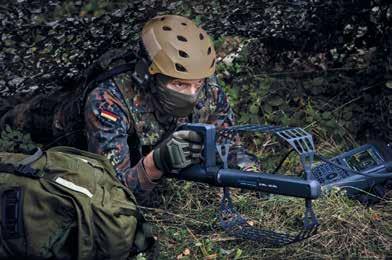
weight, flexible solutions for interference hunting in the field. Portable direction finders can be used to take bearing measurements, even on short-duration emissions. The heart of an interference hunting system are portable handheld spectrum analyzers.
Satellite link planning can be used to understand both the total budget for a SATCOM link, as well as to assess the potential impact of jamming and the associated required jamming power. Rohde & Schwarz SATCOM analysis and optimisation software solutions cover all aspects of modern satellite communications. These solutions accurately model weather conditions and atmospheric effects, while covering all RF transmission impairments of transparent payloads among all SATCOM bands of interest (C, X, Ku, Ka band etc). Major signal impairments due to intermodulation and power robbing, for example, are accurately modeled and verified against vendor data and in orbit test campaigns.
Space EW is a complex and emerging warfighting domain that presents a number of unique operational challenges. The ability to operate without constraint in space provides integral support to military, commercial and civilian applications. Traditional cost barriers to space are rapidly falling, enabling more countries and a wider range of commercial endeavors to be undertaken. These advancements are creating new opportunities, but they are also creating new risks to space and ground-based communications, navigation, weather and reconnaissance activities. Foreign governments have recognised the benefits of spacebased operations and are taking steps to maximise their advantages and formulate methods to minimise their adversaries’ capabilities. In the 1960s, the space race commenced. 60 years later, the race is on to field technologies that facilitate control over the space environment and the ground support services. At the forefront of this new space race is the invisible fight for control of the electromagnetic domain. ■





















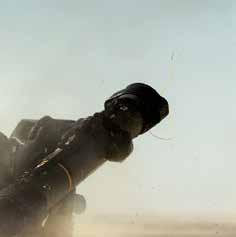





















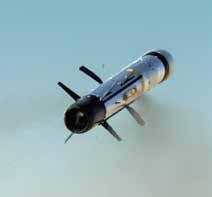









by Hartmut Bühl, Paris
On 10th April 2024, the European Defence Agency (EDA) took a big step forward in the early detection and reconnaissance of chemical, biological, radiological and nuclear (CBRN) incidents.
EDA and the five nations (Austria, France, Hungary, Croatia and Slovenia) participating in the PESCO project, Chemical, Biological, Radiological, Nuclear Surveillance as Service (CBRN SaaS) presented their impressive technological demonstrator at the military terrain of Allentsteig (Austria) to an international audience. This performance closed the programme’s Phase 1 of Initial Operational Capability (IOC).
The objective of EDA’s Category B project, CBRN SaaS under PESCO, launched in 2018, was to develop and test a technological demonstrator together with contributing Member States and an Industrial Consortium. This PESCO project is closely linked to the CBRN Reconnaissance and Surveillance System (CBRN RSS) project of the European Defence Industrial Development Programme (EDIDP).
Colonel (AT) Friedrich Aflenzer, Project Officer for CBRN Defence at EDA, explained: “Although the EU-led CBRN SaaS programme, jointly funded by the contributing Member States with €3,7m, and the EDIDP project with a funding of €6,7m, remain separate, they have cooperated to produce a single technological demonstrator.” He added that “compliance with the EU operational objectives is the leitmotiv of our cooperation”.
The overall objective of the project is to establish a network of sensors linking flying objects such as drones of all kinds and Unmanned Aerial Vehicles (UAVs), but also vehicles on the ground, so-called Unmanned Ground Systems (UGSs). “These unmanned sensors aim to heighten operational information shared across commands, troops position and the status of threats in each EU operation”, explained Colonel (GS, AT) Jürgen Schlechter, Commanding Officer at the Austrian CBRN Defence Centre, and responsible for the presentation at Allentsteig.
The presentation was specifically designed for CBRN commanders and capability planners at defence and other relevant ministries and aimed at giving them the opportunity to learn about unmanned CBRN defence and IT solutions. Industry partners in
© Bundesheer
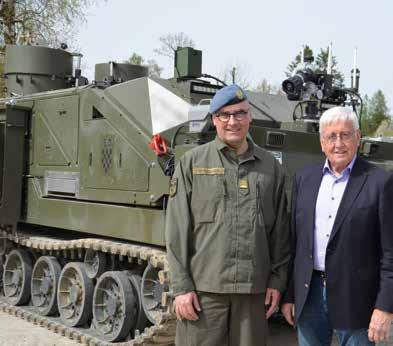
Colonel (GS, AT) Jürgen Schlechter, Commanding Officer at the Austrian CBRN Defence Centre (left) and Hartmut Bühl in front of the CBRN SaaS/RSS technological demonstrator during the presentation event in Austria
the project of the contributing Member States were authorised to expose their products at Allentsteig.
The visitors were given initial information during the bus trip from the famous Austrian Military Academy in Vienna to Allentsteig, a manoeuvre terrain of the Bundesheer, created before World War II, where the presentation was to take place. We were told that the military and staff from the industries present had worked all night to make the day a success. It should also be noted that the system was subjected to an intensive test phase throughout the previous week.
We then received more details on the project. The organiser highlighted that the Reconnaissance Surveillance System (RSS) project builds a modular purely European-built CBRN Intelligence, Surveillance and Reconnaissance (ISR) solution for CBRN Detection, Identification and Monitoring (DIM) and that this creates the technical “glue” for a cooperative European-built CBRN ISR architecture. The solution is designed as a highly adaptive “system of systems” with a focus on system evolution and infor-


mation flow. The system supports the iterative deployment and replaceability, as well as flexible use of available components for joint missions. In line with EU-wide initiatives, CBRN SaaS/RSS is designed around the EU’s cooperative initiatives like PESCO and EU Battlegroups and is based on the needs of Member States’ MoDs.
The scenario of the field exercise
Before the demonstration started, the briefing of the situation on the ground raised visitors’ expectations:

Genesis of the CBRN SaaS project
• 2017 multinational project initiation
• 2018 Start of PESCO project to develop a new EU military capability
Phase 1
• 2019 Ministers signed a Project Arrangement with EDA for Phase 1 to develop & test a demonstrator before the end of May 2024, reporting results and making recommendation for Phase 2.1
Phase 2.1
• 1 June 2024 to 31 December 2026
• Detailed planning of all Lines of Development (LoD)
• Militarisation of the demonstrator
• Testing in military operational settings
Phase 2.2
• Procurement starting 2027

LOCATION: The village of STEINBACH1 is an important railway station for the deployment of troops. Dangerous goods and ammunition are transhipped and temporarily stored there.
FORCES: An infantry unit is in place to secure the area. The semi-autonomous CBRN Reconnaissance and Surveillance unit (CBRN RSU) is held in high readiness at an assembly area and is equipped with Large Unmanned Aerial Vehicle Systems (LUAVs), Small Unmanned Aerial Vehicle Systems (SUAVs), and Unmanned Ground Vehicles (UGV).
SITUATION UPDATE: An attack with a radiological device has taken place. An ammonia container has been damaged and ammonia has been released.
MISSION FOR CBRN SaaS/RSS: Clarify the situation and determine the extent of the contamination. Take samples. Create a recognised CBRN picture.
Mission execution
Shortly after the explosion around the train station, observers followed a small UAV – the Elevox Tango VTOL CBRN platform from the Slovenian company OneDrone – measuring the extent of the disaster area. Thanks to its VTOL capabilities, the UAV descended close to the ground, using its sensors to retrieve the first data, which were delivered to the Data Fusion Centre.
After a first assessment, a large UAV – an Austrian Schiebel CAMCOPTER – flew over the terrain taking supplementary data and pictures which were delivered to the Data Fusion Cell. Finally, a UGV from the Croatian company DOK-ING could be moved in situ to collect material necessary for the establishment of the recognised CBRN picture.
At the end of the day, my congratulations for a perfect demonstrator performance thanks to the Bundesheer as the leader, together with the Industrial Consortium and the guiding hand of the European Defence Agency. ■
Interview with Chua Jin Kiat, Executive Vice President, International Defence Business, ST Engineering, Singapore
With our magazine, we have been following European and international efforts in civil protection and disaster management for years. For this edition, we asked a Singapore-based company about collaboration projects and the company's contribution to protecting people in south-east Asia and beyond.
The European: Mr Chua, ST Engineering, headquartered in Singapore, brings products and services for the aerospace, smart city, defence, marine and public security sectors under one roof. In summary, is the protection of people at the heart of your business?
Chua Jin Kiat: Yes, we are committed to applying our technology and innovation to solve real-world problems and improve lives, and this extends to saving lives and fostering resilient communities. With our deep expertise in defence technology and engineering across the land, air, space, and sea domains, we are uniquely equipped to support communities in times of crisis. Our capabilities
seamlessly extend to the protection of people, covering Humanitarian Assistance and Disaster Relief (HADR), critical infrastructure, intelligence operations, homeland security applications, maritime safety and security systems, and satellite technology.
The European: In the field of civil protection and disaster management, are you engaged in cooperation projects with other countries in your region or beyond?
Chua Jin Kiat: Yes, as the escalation of natural disasters due to climate change is a growing concern, efforts to address civil protection and disaster management are evident across various regions. We at ST Engineering actively foster collaborative initiatives and partnerships to bolster support for disaster management. For instance, we collaborated with a partner in Mexico to deploy ExtremV, our commercial all terrain tracked carrier, as part of a hurricane rescue mission last year. We are also developing an aerial firefighting platform based on the Boeing 757 aircraft with Galactic Holdings.

ST Engineering’s all terrain tracked carrier ExtremV was deployed during the Otis Hurricane disaster rescue mission in Mexico (2023)

The European: You mentioned ExtremV. Can you give some more details on this new product serving HADR teams?
Chua Jin Kiat: Unlike standard emergency vehicles, ExtremV is the follow-up vehicle to the famous Bronco ATTC, but in a lighter and non-armoured version. It was designed to traverse the most challenging terrains and withstand extreme climate conditions encountered in emergency situations. ExtremV ensures exceptional terrain accessibility with its 4x4 capability and low ground pressure and features a differential lock to address slippery slopes and soft grounds, such as snow or swamp land. Moreover, it excels in navigating tight spaces
ner. Our multiservice satcom platform allows emergency and disaster recovery teams to access a communications network over satellite from the early stages after the disaster, up to the restoration of the terrestrial communication infrastructure. Mission-critical communication lines over satellite are also available at all times without service interruption or loss of data, thanks to our auto-adaptive modulation technology inside our modems.
The European: All of this can only work if digital communication is protected. What expertise does your company have in cyber resilience?

“ We are committed to applying our technology and innovation to solve real-world problems.”
©
Chua Jin Kiat is Executive Vice President, International Defence Business at ST Engineering in Singapore
and climbing slopes and is designed to operate in temperatures ranging from -46C to 49C. The vehicle has a high payload capacity of four to six tonnes, which makes it a crucial asset in HADR missions for transporting aid, equipment and personnel. Its amphibious capability enhances its versatility, while the modular payload accommodates various mission requirements.
The European: Where has the vehicle been deployed so far?
Chua Jin Kiat: ExtremV was recently deployed in Mexico, but also in Japan for their hurricane relief, flood and earthquake rescue missions. It has also been deployed in Germany and Finland for forest fire fighting, off-road power transmission lines, gas pipeline repair and inspection.
The European: Do you also propose training in the area of HADR?
Chua Jin Kiat: Yes, we introduced the Emergency Response Driving Simulator, an innovative simulation training tool. It offers high-fidelity and realistic virtual training experiences for various types of response vehicles, such as ambulances and fire engines. By using this advanced technology, emergency responders can enhance their skills and readiness to effectively navigate challenging scenarios, ultimately improving their ability to respond to emergencies with precision and confidence.
The European: And how do you ensure reliable communications when a disaster strikes?
Chua Jin Kiat: Through our satellite communications ground systems technology, reliable satellite links can be set up quickly anywhere in the world in a flexible, scalable and efficient man-
Chua Jin Kiat: Indeed, cyber threats are ever-present, extending even onto the battlefield. At ST Engineering, we offer a comprehensive suite of solutions designed to fortify networks, critical infrastructure, and systems against evolving threats. Our services and solutions cover cryptography, cybersecurity engineering, digital authentication, SCADA protection, audit and compliance. We also design and build security operation centres for cybersecurity professionals and manage security services customers in national, government, and critical information infrastructures and commercial enterprises.
The European: What kind of training do you offer in this field?
Chua Jin Kiat: For cyber threats, we have a robust regime to increase employee awareness and fortify our cyber defences, including annual e-learning courses and phishing email campaigns. We also offer cybersecurity training through our Cybersecurity Academy (STECA) established in 2014. STECA has certified and trained more than 2,000 cybersecurity professionals from over 150 organisations.
The European: The maritime industry has experienced a notable increase in risks and complexities, including piracy, smuggling, terrorism, and accidents occurring at ports and on the high seas. Could you share more on ST Engineering’s maritime safety and security solutions?
Chua Jin Kiat: In response to these challenges, our comprehensive suite of maritime safety and security solutions provides surveillance, situational awareness, collision avoidance detection, and anti-piracy measures for both maritime and coastal domains. Using advanced technologies, including smart mobility tracking, video and behaviour analytics, and our proprietary Track-BeforeDetect technology for detecting small targets at sea, our solutions empower stakeholders with actionable intelligence to mitigate such risks and enhance security measures. We also design, build, and offer through-life support from repair, maintenance to retrofitting and upgrading for a wide range of naval ships suited for maritime security, HADR and specialised missions.
The European: Mr Chua, thank you for the time you gave for this conversation. ■



